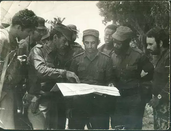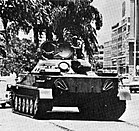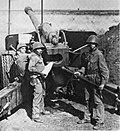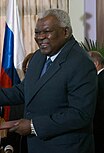Cuba
Republic of Cuba República de Cuba (Spanish) | |
|---|---|
| Motto: Patria o Muerte, Venceremos ("Homeland or Death, We Shall Overcome!")[1] | |
| Anthem: La Bayamesa ("The Bayamo Song")[2] | |
 Cuba, shown in dark green | |
| Capital and largest city | Havana 23°8′N 82°23′W / 23.133°N 82.383°W |
| Official languages | Spanish |
| Other spoken languages | Haitian Creole English Lucumí Galician Corsican |
| Ethnic groups |
|
| Religion (2020)[4] |
|
| Demonym(s) | Cuban |
| Government | Unitary Marxist–Leninist one-party socialist republic[5][6] |
| Miguel Díaz-Canel | |
| Salvador Valdés Mesa | |
| Manuel Marrero Cruz | |
| Esteban Lazo Hernández | |
| Legislature | National Assembly of People's Power |
| Independence from Spain and the United States | |
| 10 October 1868 | |
| 24 February 1895 | |
• Recognized (Handed over to the United States from Spain) | 10 December 1898 |
• Republic declared (Independence from United States) | 20 May 1902 |
| 26 July 1953 – 1 January 1959 | |
| 10 April 2019 | |
| Area | |
• Total | 110,860[7] km2 (42,800 sq mi) (104th) |
• Water (%) | 0.94 |
| Population | |
• 2023 estimate | |
• 2022 census | |
• Density | 90.7/km2 (234.9/sq mi) (80th) |
| GDP (PPP) | 2015 estimate |
• Total | $254.865 billion[11] |
• Per capita | $22,237[11][12] |
| GDP (nominal) | 2022 estimate |
• Total | |
• Per capita | |
| Gini (2000) | 38.0[14] medium inequality |
| HDI (2022) | high (85th) |
| Currency | Cuban peso (CUP) |
| Time zone | UTC−5 (CST) |
• Summer (DST) | UTC−4 (CDT) |
| Calling code | +53 |
| ISO 3166 code | CU |
| Internet TLD | .cu |
Cuba,[c] officially the Republic of Cuba,[d] is an island country, comprising the island of Cuba (largest island), Isla de la Juventud, and 4,195 islands, islets and cays surrounding the main island. It is located where the northern Caribbean Sea, Gulf of Mexico, and Atlantic Ocean meet. Cuba is located east of the Yucatán Peninsula (Mexico), south of both Florida and the Bahamas, west of Hispaniola (Haiti/Dominican Republic), and north of Jamaica and the Cayman Islands. Havana is the largest city and capital. Cuba is the third-most populous country in the Caribbean after Haiti and the Dominican Republic, with about 10 million inhabitants. It is the largest country in the Caribbean by area.
The territory that is now Cuba was inhabited as early as the 4th millennium BC, with the Guanahatabey and Taíno peoples inhabiting the area at the time of Spanish colonization in the 15th century.[16] It was then a colony of Spain, through the abolition of slavery in 1886, until the Spanish–American War of 1898, when Cuba was occupied by the United States and gained independence in 1902. In 1940, Cuba implemented a new constitution, but mounting political unrest culminated in the 1952 Cuban coup d'état and the subsequent dictatorship of Fulgencio Batista.[17] The Batista government was overthrown in January 1959 by the 26th of July Movement during the Cuban Revolution. That revolution established communist rule under the leadership of Fidel Castro.[18][19] The country was a point of contention during the Cold War between the Soviet Union and the United States, and the Cuban Missile Crisis of 1962 is widely considered the closest the Cold War came to escalating into nuclear war. Following the dissolution of the Soviet Union, Cuba faced a severe economic downturn in the 1990s, known as the Special Period. In 2008, Fidel Castro retired after 49 years; Raúl Castro was elected his successor. Raúl Castro retired as president in 2018 and Miguel Díaz-Canel was elected president by the National Assembly following parliamentary elections. Raúl Castro retired as First Secretary of the Communist Party in 2021 and Díaz-Canel was elected.
Cuba is a socialist state, in which the role of the Communist Party is enshrined in the Constitution. Cuba has an authoritarian government where political opposition is not permitted.[20][21] Censorship is extensive and independent journalism is repressed;[22][23][24] Reporters Without Borders has characterized Cuba as one of the worst countries for press freedom.[25][24] Culturally, Cuba is considered part of Latin America.[26] It is a multiethnic country whose people, culture and customs derive from diverse origins, including the Taíno Ciboney peoples, the long period of Spanish colonialism, the introduction of enslaved Africans and a close relationship with the Soviet Union during the Cold War.
Cuba is a founding member of the United Nations, G77, Non-Aligned Movement, Organisation of African, Caribbean and Pacific States, ALBA, and Organization of American States. It has one of the world's few planned economies, and its economy is dominated by tourism and the exports of skilled labor, sugar, tobacco, and coffee. Cuba has historically—before and during communist rule—performed better than other countries in the region on several socioeconomic indicators, such as literacy,[27][28] infant mortality and life expectancy. Cuba has a universal health care system which provides free medical treatment to all Cuban citizens,[29][30] although challenges include low salaries for doctors, poor facilities, poor provision of equipment, and the frequent absence of essential drugs.[31][32] A 2023 study by the Cuban Observatory of Human Rights (OCDH), estimated 88% of the population is living in extreme poverty.[33] The traditional diet is of international concern due to micronutrient deficiencies and lack of diversity. As highlighted by the World Food Programme (WFP) of the United Nations, rationed food meets only a fraction of daily nutritional needs for many Cubans, leading to health issues.[34]
Etymology
Historians believe the name Cuba comes from the Taíno language; however, "its exact derivation [is] unknown".[35] The exact meaning of the name is unclear, but it may be translated either as 'where fertile land is abundant' (cubao),[36] or 'great place' (coabana).
History
Pre-Columbian era
Humans first settled Cuba around 6,000 years ago, descending from migrations from northern South America or Central America.[37] The arrival of humans on Cuba is associated with extinctions of the islands native fauna, particularly its endemic sloths.[38] The Arawakan-speaking ancestors of the Taíno people arrived in the Caribbean in a separate migration from South America around 1,700 years ago. Unlike the previous settlers of Cuba, the Taíno extensively produced pottery and engaged in intensive agriculture.[37] The earliest evidence of the Taíno people on Cuba dates to the 9th century AD.[39] Descendants of the first settlers of Cuba persisted on the western part of the island until Columbian contact, where they were recorded as the Guanahatabey people, who lived a hunter-gatherer lifestyle.[40][37]
Spanish colonization and rule (1492–1898)
After first landing on an island then called Guanahani on 12 October 1492,[41] Christopher Columbus landed on Cuba on 27 October 1492, and landing in the northeastern coast on 28 October.[42] Columbus claimed the island for the new Kingdom of Spain[43] and named it Isla Juana ("John's Island") after John, Prince of Asturias.[44]
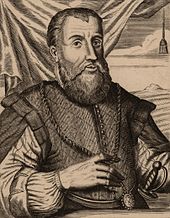
In 1511, the first Spanish settlement was founded by Diego Velázquez de Cuéllar at Baracoa. Other settlements soon followed, including San Cristobal de la Habana, founded in 1514 (southern coast of the island) and then in 1519 (current place), which later became the capital (1607). The Indigenous Taíno were forced to work under the encomienda system,[45] which resembled the feudal system in medieval Europe.[46] Within a century, the Indigenous people faced high incidence of mortality due to multiple factors, primarily Eurasian infectious diseases, to which they had no natural resistance (immunity), aggravated by the harsh conditions of the repressive colonial subjugation.[47] In 1529, a measles outbreak killed two-thirds of those few Natives who had previously survived smallpox.[48][49]
On 18 May 1539, conquistador Hernando de Soto departed from Havana with some 600 followers into a vast expedition through the American Southeast, in search of gold, treasure, fame and power.[50] On 1 September 1548, Gonzalo Perez de Angulo was appointed governor of Cuba. He arrived in Santiago, Cuba, on 4 November 1549, and immediately declared the liberty of all Natives.[51] He became Cuba's first permanent governor to reside in Havana instead of Santiago, and he built Havana's first church made of masonry.[52][e]
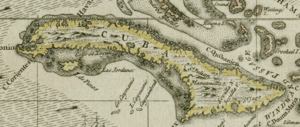
By 1570, most residents of Cuba comprised a mixture of Spanish, African, and Taíno heritages.[54] Cuba developed slowly and, unlike the plantation islands of the Caribbean, had a diversified agriculture. Most importantly, the colony developed as an urbanized society that primarily supported the Spanish colonial empire. By the mid-18th century, there were 50,000 slaves on the island, compared to 60,000 in Barbados and 300,000 in Virginia; as well as 450,000 in Saint-Domingue, all of which had large-scale sugarcane plantations.[55]
The Seven Years' War, which erupted in 1754 across three continents, eventually arrived in the Spanish Caribbean. Spain's alliance with the French pitched them into direct conflict with the British, and in 1762, a British expedition consisting of dozens of ships and thousands of troops set out from Portsmouth to capture Cuba. The British arrived on 6 June, and by August, had placed Havana under siege.[56] When Havana surrendered, the admiral of the British fleet, George Pocock and the commander of the land forces George Keppel, the 3rd Earl of Albemarle, entered the city, and took control of the western part of the island. The British immediately opened up trade with their North American and Caribbean colonies, causing a rapid transformation of Cuban society.[56]
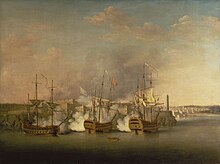
Though Havana, which had become the third-largest city in the Americas, was to enter an era of sustained development and increasing ties with North America during this period, the British occupation of the city proved short-lived. Pressure from London on sugar merchants, fearing a decline in sugar prices, forced negotiations with the Spanish over the captured territories.[clarification needed] Less than a year after Britain captured Havana, it signed the 1763 Treaty of Paris together with France and Spain, ending the Seven Years' War. The treaty gave Florida to Britain in exchange for Cuba.[f] Cubans constituted one of the many diverse units which fought alongside Spanish and Floridan forces during the conquest of British-controlled West Florida (1779–81).
The largest factor for the growth of Cuba's commerce in the late eighteenth and early nineteenth century was the Haitian Revolution. When the enslaved peoples of what had been the Caribbean's richest colony freed themselves through violent revolt, Cuban planters perceived the region's changing circumstances with both a sense of fear and opportunity. They were afraid because of the prospect that slaves might revolt in Cuba as well, and numerous prohibitions during the 1790s of the sale of slaves in Cuba who had previously been enslaved in French colonies underscored this anxiety. The planters saw opportunity, however, because they thought that they could exploit the situation by transforming Cuba into the slave society and sugar-producing "pearl of the Antilles" that Haiti had been before the revolution.[57] As the historian Ada Ferrer has written, "At a basic level, liberation in Saint-Domingue helped entrench its denial in Cuba. As slavery and colonialism collapsed in the French colony, the Spanish island underwent transformations that were almost the mirror image of Haiti's."[58] Estimates suggest that between 1790 and 1820 some 325,000 Africans were imported to Cuba as slaves, which was four times the amount that had arrived between 1760 and 1790.[59]

Although a smaller proportion of the population of Cuba was enslaved, at times, slaves arose in revolt. In 1812, the Aponte Slave Rebellion took place, but it was ultimately suppressed.[60] The population of Cuba in 1817 was 630,980 (of which 291,021 were white, 115,691 were free people of color (mixed-race), and 224,268 black slaves).[61][g]
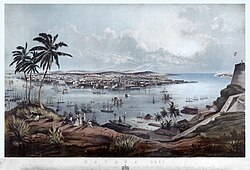
In part due to Cuban slaves working primarily in urbanized settings, by the 19th century, the practice of coartacion had developed (or "buying oneself out of slavery", a "uniquely Cuban development"), according to historian Herbert S. Klein.[63] Due to a shortage of white labor, blacks dominated urban industries "to such an extent that when whites in large numbers came to Cuba in the middle of the nineteenth century, they were unable to displace Negro workers."[55] A system of diversified agriculture, with small farms and fewer slaves, served to supply the cities with produce and other goods.[55]
In the 1820s, when the rest of Spain's empire in Latin America rebelled and formed independent states, Cuba remained loyal to Spain. Its economy was based on serving the empire. By 1860, Cuba had 213,167 free people of color (39% of its non-white population of 550,000).[55][h]
Independence movements
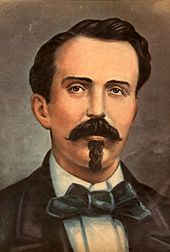
Full independence from Spain was the goal of a rebellion in 1868 led by planter Carlos Manuel de Céspedes. De Céspedes, a sugar planter, freed his slaves to fight with him for an independent Cuba. On 27 December 1868, he issued a decree condemning slavery in theory but accepting it in practice and declaring free any slaves whose masters present them for military service.[64] The 1868 rebellion resulted in a prolonged conflict known as the Ten Years' War. A great number of the rebels were volunteers from the Dominican Republic,[j] and other countries, as well as numerous Chinese indentured servants.[66][k][l]
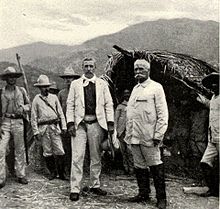
The United States declined to recognize the new Cuban government, although many European and Latin American nations did so.[69] In 1878, the Pact of Zanjón ended the conflict, with Spain promising greater autonomy to Cuba.[m] In 1879–80, Cuban patriot Calixto García attempted to start another war known as the Little War but failed to receive enough support.[71] Slavery in Cuba was abolished in 1875 but the process was completed only in 1886.[72][73] An exiled dissident named José Martí founded the Cuban Revolutionary Party in New York City in 1892. The aim of the party was to achieve Cuban independence from Spain.[74] In January 1895, Martí traveled to Monte Cristi and Santo Domingo in the Dominican Republic to join the efforts of Máximo Gómez.[74] Martí recorded his political views in the Manifesto of Montecristi.[75] Fighting against the Spanish army began in Cuba on 24 February 1895, but Martí was unable to reach Cuba until 11 April 1895.[74] Martí was killed in the Battle of Dos Rios on 19 May 1895.[74] His death immortalized him as Cuba's national hero.[75]

Around 200,000 Spanish troops outnumbered the much smaller rebel army, which relied mostly on guerrilla and sabotage tactics. The Spaniards began a campaign of suppression. General Valeriano Weyler, the military governor of Cuba, herded the rural population into what he called reconcentrados, described by international observers as "fortified towns". These are often considered the prototype for 20th-century concentration camps.[76] Between 200,000[77] and 400,000 Cuban civilians died from starvation and disease in the Spanish concentration camps, numbers verified by the Red Cross and United States Senator Redfield Proctor, a former Secretary of War. American and European protests against Spanish conduct on the island followed.[78]
The U.S. battleship USS Maine was sent to protect American interests, but soon after arrival, it exploded in Havana harbor and sank quickly, killing nearly three-quarters of the crew. The cause and responsibility for the sinking of the ship remained unclear after a board of inquiry. Popular opinion in the U.S., fueled by active yellow press, concluded that the Spanish were to blame and demanded action.[79] Spain and the United States declared war on each other in late April 1898.[n][o]
Republic (1902–1959)
First years (1902–1925)
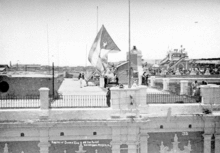
After the Spanish–American War, Spain and the United States signed the Treaty of Paris (1898), by which Spain ceded Puerto Rico, the Philippines, and Guam to the United States for the sum of US$20 million[84] and Cuba became a protectorate of the United States. Cuba gained formal independence from the U.S. on 20 May 1902, as the Republic of Cuba.[85] Under Cuba's new constitution, the U.S. retained the right to intervene in Cuban affairs and to supervise its finances and foreign relations. Under the Platt Amendment, the U.S. leased the Guantánamo Bay Naval Base from Cuba.
Following disputed elections in 1906, the first president, Tomás Estrada Palma, faced an armed revolt by independence war veterans who defeated the meager government forces.[86] The U.S. intervened by occupying Cuba and named Charles Edward Magoon as Governor for three years. Cuban historians have characterized Magoon's governorship as having introduced political and social corruption.[87] In 1908, self-government was restored when José Miguel Gómez was elected president, but the U.S. continued intervening in Cuban affairs. In 1912, the Partido Independiente de Color attempted to establish a separate black republic in Oriente Province,[88] but was suppressed by General Monteagudo with considerable bloodshed.
In 1924, Gerardo Machado was elected president.[89] During his administration, tourism increased markedly, and American-owned hotels and restaurants were built to accommodate the influx of tourists.[89] The tourist boom led to increases in gambling and prostitution in Cuba.[89] The Wall Street Crash of 1929 led to a collapse in the price of sugar, political unrest, and repression.[90] Protesting students, known as the Generation of 1930, turned to violence in opposition to the increasingly unpopular Machado.[90] A general strike (in which the Communist Party sided with Machado),[91] uprisings among sugar workers, and an army revolt forced Machado into exile in August 1933. He was replaced by Carlos Manuel de Céspedes y Quesada.[90]
Revolution of 1933–1940
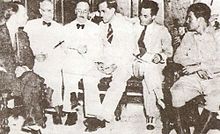
In September 1933, the Sergeants' Revolt, led by Sergeant Fulgencio Batista, overthrew Céspedes.[92] A five-member executive committee (the Pentarchy of 1933) was chosen to head a provisional government.[93] Ramón Grau San Martín was then appointed as provisional president.[93] Grau resigned in 1934, leaving the way clear for Batista, who dominated Cuban politics for the next 25 years, at first through a series of puppet-presidents.[92] The period from 1933 to 1937 was a time of "virtually unremitting social and political warfare".[94] On balance, during the period 1933–1940 Cuba suffered from fragile political structures, reflected in the fact that it saw three different presidents in two years (1935–1936), and in the militaristic and repressive policies of Batista as Head of the Army.
Constitution of 1940
A new constitution was adopted in 1940, which engineered radical progressive ideas, including the right to labor and health care.[95] Batista was elected president in the same year, holding the post until 1944.[96] He is so far the only non-white Cuban to win the nation's highest political office.[97][98][99] His government carried out major social reforms. Several members of the Communist Party held office under his administration.[100] Cuban armed forces were not greatly involved in combat during World War II—though president Batista did suggest a joint U.S.-Latin American assault on Francoist Spain to overthrow its authoritarian regime.[101] Cuba lost six merchant ships during the war, and the Cuban Navy was credited with sinking the German submarine U-176.[102]
Batista adhered to the 1940 constitution's strictures preventing his re-election.[103] Ramon Grau San Martin was the winner of the next election, in 1944.[96] Grau further corroded the base of the already teetering legitimacy of the Cuban political system, in particular by undermining the deeply flawed, though not entirely ineffectual, Congress and Supreme Court.[104] Carlos Prío Socarrás, a protégé of Grau, became president in 1948.[96] The two terms of the Auténtico Party brought an influx of investment, which fueled an economic boom, raised living standards for all segments of society, and created a middle class in most urban areas.[105]
Coup d'état of 1952

After finishing his term in 1944 Batista lived in Florida, returning to Cuba to run for president in 1952. Facing certain electoral defeat, he led a military coup that preempted the election.[106] Back in power, and receiving financial, military, and logistical support from the United States government, Batista suspended the 1940 Constitution and revoked most political liberties, including the right to strike. He then aligned with the wealthiest landowners who owned the largest sugar plantations, and presided over a stagnating economy that widened the gap between rich and poor Cubans.[107] Batista outlawed the Cuban Communist Party in 1952.[108] After the coup, Cuba had Latin America's highest per capita consumption rates of meat, vegetables, cereals, automobiles, telephones and radios, though about one-third of the population was considered poor and enjoyed relatively little of this consumption.[109] However, in his "History Will Absolve Me" speech, Fidel Castro mentioned that national issues relating to land, industrialization, housing, unemployment, education, and health were contemporary problems.[110]
In 1958, Cuba was a well-advanced country in comparison to other Latin American regions.[111] Cuba was also affected by perhaps the largest labor union privileges in Latin America, including bans on dismissals and mechanization. They were obtained in large measure "at the cost of the unemployed and the peasants", leading to disparities.[112] Between 1933 and 1958, Cuba extended economic regulations enormously, causing economic problems.[97][113] Unemployment became a problem as graduates entering the workforce could not find jobs.[97] The middle class, which was comparable to that of the United States[how?], became increasingly dissatisfied with unemployment and political persecution. The labor unions, manipulated by the previous government since 1948 through union "yellowness", supported Batista until the very end.[97][98] Batista stayed in power until he resigned in December 1958 under the pressure of the US Embassy and as the revolutionary forces headed by Fidel Castro were winning militarily (Santa Clara city, a strategic point in the middle of the country, fell into the rebels hands on December 31, in a conflict known as the Battle of Santa Clara).[114][115]
Revolution and Communist Party rule (1959–present)

In the 1950s, various organizations, including some advocating armed uprising, competed for public support in bringing about political change.[116] In 1956, Fidel Castro and about 80 supporters landed from the yacht Granma in an attempt to start a rebellion against the Batista government.[116] In 1958, Castro's July 26th Movement emerged as the leading revolutionary group.[116] The U.S. supported Castro by imposing a 1958 arms embargo against Batista's government. Batista evaded the American embargo and acquired weapons from the Dominican Republic.[p]
By late 1958, the rebels had broken out of the Sierra Maestra and launched a general popular insurrection. After Castro's fighters captured Santa Clara, Batista fled with his family to the Dominican Republic on 1 January 1959. Later he went into exile on the Portuguese island of Madeira and finally settled in Estoril, near Lisbon. Fidel Castro's forces entered the capital on 8 January 1959. The liberal Manuel Urrutia Lleó became the provisional president.[122]
According to Amnesty International, official death sentences from 1959 to 1987 numbered 237 of which all but 21 were carried out.[123] The vast majority of those executed directly following the 1959 Revolution were policemen, politicians, and informers of the Batista regime accused of crimes such as torture and murder, and their public trials and executions had widespread popular support among the Cuban population.[124]

The United States government initially reacted favorably to the Cuban Revolution, seeing it as part of a movement to bring democracy to Latin America.[126] Castro's legalization of the Communist Party and the hundreds of executions of Batista agents, policemen, and soldiers that followed caused a deterioration in the relationship between the two countries.[126] The promulgation of the Agrarian Reform Law, expropriating thousands of acres of farmland (including from large U.S. landholders), further worsened relations.[126][127] In response, between 1960 and 1964 the U.S. imposed a range of sanctions, eventually including a total ban on trade between the countries and a freeze on all Cuban-owned assets in the U.S.[128] In February 1960, Castro signed a commercial agreement with Soviet Vice-Premier Anastas Mikoyan.[126]
In March 1960, U.S. President Dwight D. Eisenhower gave his approval to a CIA plan to arm and train a group of Cuban refugees to overthrow the Castro government. The invasion (known as the Bay of Pigs Invasion) took place on 14 April 1961, during the term of President John F. Kennedy.[127] About 1,400 Cuban exiles disembarked at the Bay of Pigs. Cuban troops and local militias defeated the invasion, killing over 100 invaders and taking the remainder prisoner.[127] In January 1962, Cuba was suspended from the Organization of American States (OAS), and later the same year the OAS started to impose sanctions against Cuba of similar nature to the U.S. sanctions.[129] The Cuban Missile Crisis of October 1962 almost sparked World War III.[130][131] In 1962 American generals proposed Operation Northwoods which would entail committing terrorist attacks in American cities and against refugees and falsely blaming the attacks on the Cuban government, manufacturing a reason for the United States to invade Cuba. This plan was rejected by President Kennedy.[132] By 1963, Cuba was moving towards a full-fledged communist system modeled on the USSR.[133]
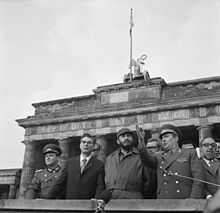
During the Cold War, Cuban forces were deployed to all corners of Africa, either as military advisors or as combatants.[134] In 1963, Cuba sent 686 troops together with 22 tanks and other military equipment to support Algeria in the Sand War against Morocco.[135] The Cuban forces remained in Algeria for over a year, providing training to the Algerian army.[136] In 1964, Cuba organized a meeting of Latin American communists in Havana and stoked a civil war in the capital of the Dominican Republic in 1965, which prompted 20,000 U.S. troops to intervene there.[54] Che Guevara engaged in guerrilla activities in Africa and was killed in 1967 while attempting to start a revolution in Bolivia.[54] During the 1970s, Fidel Castro dispatched tens of thousands of troops in support of Soviet-backed wars in Africa. He supported the MPLA in Angola (Angolan Civil War) and Mengistu Haile Mariam in Ethiopia (Ogaden War).[137]
In November 1975, Cuba deployed more than 65,000 troops and 400 Soviet-made tanks in Angola in one of the fastest military mobilizations in history.[138] South Africa developed nuclear weapons due to the threat to its security posed by the presence of large numbers of Cuban troops in Angola.[139] In 1976 and again in 1988 at the Battle of Cuito Cuanavale, the Cubans alongside their MPLA allies defeated UNITA rebels and apartheid South African forces.[140][q] In December 1977, Cuba sent its combat troops from Angola, the People's Republic of the Congo, and the Caribbean to Ethiopia,[136] assisted by mechanized Soviet battalions, to help defeat a Somali invasion. On 24 January 1978, Ethiopian and Cuban troops counterattacked, inflicting 3,000 casualties on the Somali forces.[136] In February, Cuban troops launched a major offensive and forced the Somali army back into its own territory.[136][142] Cuban forces remained in Ethiopia until 9 September 1989.[136]
Despite Cuba's small size and the long distance separating it from the Middle East, Castro's Cuba played an active role in the region during the Cold War. In 1972, a major Cuban military mission consisting of tank, air, and artillery specialists was dispatched to South Yemen. Cuban military advisors were sent to Iraq in the mid-1970s but their mission was canceled after Iraq invaded Iran in 1980.[136] The Cubans were also involved in the Syrian-Israeli War of Attrition (November 1973–May 1974) that followed the Yom Kippur War (October 1973).[143] Israeli sources reported the presence of a Cuban tank brigade in the Golan Heights, which was supported by two brigades.[144] The Israelis and the Cuban-Syrian tank forces engaged in battle on the Golan front.[145]: 37–38
The standard of living in the 1970s was "extremely spartan" and discontent was rife.[146] Fidel Castro admitted the failures of economic policies in a 1970 speech.[146] In 1975, the OAS lifted its sanctions against Cuba, with the approval of 16 member states, including the United States. The U.S., however, maintained its own sanctions.[129] In 1979, the U.S. objected to the presence of Soviet combat troops on the island.[54] Following the 1983 coup that resulted in the execution of Grenadian Prime Minister Maurice Bishop and establishment of the military government led by Hudson Austin, U.S. forces invaded Grenada in 1983, overthrowing the Government. Most resistance came from Cuban construction workers, while the Grenadan People's Revolutionary Army and militia surrendered without putting up much of a fight. 24 Cubans were killed, with only 2 of them being professional soldiers, and the remainder were expelled from the island. U.S. casualties amounted to 19 killed, 116 wounded, and 9 helicopters destroyed. During the 1970s and 1980s, Castro supported Marxist insurgencies in Guatemala, El Salvador, and Nicaragua. Cuba gradually withdrew its troops from Angola in 1989–91.[136] An important psychological and political aspect of the Cuban military involvement in Africa was the significant presence of black or mixed-race soldiers among the Cuban forces.[136][r] According to one source, more than 300,000 Cuban military personnel and civilian experts were deployed in Africa. The source also states that out of the 50,000 Cubans sent to Angola, half contracted AIDS and that 10,000 Cubans died as a consequence of their military actions in Africa.[136]

Soviet troops began to withdraw from Cuba in September 1991,[54] and Castro's rule was severely tested in the aftermath of the Soviet collapse in December 1991 (known in Cuba as the Special Period). The country faced a severe economic downturn following the withdrawal of Soviet subsidies worth $4 billion to $6 billion annually, resulting in effects such as food and fuel shortages.[148][149] The government did not accept American donations of food, medicines and cash until 1993.[148] On 5 August 1994, state security dispersed protesters in a spontaneous protest in Havana. From the start of the crisis until 1995, Cuba saw its gross domestic product (GDP) shrink by 35%. It took another five years for its GDP to reach pre-crisis levels.[150]
Cuba has since found a new source of aid and support in the People's Republic of China. In addition, Hugo Chávez, then president of Venezuela, and Evo Morales, former president of Bolivia, became allies and both countries are major oil and gas exporters. In 2003, the government arrested and imprisoned a large number of civil activists, a period known as the "Black Spring".[151][152]
In February 2008, Fidel Castro resigned as President of the State Council due to the serious gastrointestinal illness which he had suffered since July 2006.[153] On 24 February, the National Assembly elected his brother Raúl Castro the new president.[154] In his inauguration speech, Raúl promised that some of the restrictions on freedom in Cuba would be removed.[155] In March 2009, Raúl Castro removed some of his brother's appointees.[156]
On 3 June 2009, the Organization of American States adopted a resolution to end the 47-year ban on Cuban membership of the group.[157] The resolution stated, however, that full membership would be delayed until Cuba was "in conformity with the practices, purposes, and principles of the OAS".[129] Fidel Castro wrote that Cuba would not rejoin the OAS, which, he said, was a "U.S. Trojan horse" and "complicit" in actions taken by the U.S. against Cuba and other Latin American nations.[158]
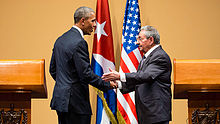
Effective 14 January 2013, Cuba ended the requirement established in 1961, that any citizens who wish to travel abroad were required to obtain an expensive government permit and a letter of invitation.[159][160][161] In 1961 the Cuban government had imposed broad restrictions on travel to prevent the mass emigration of people after the 1959 revolution;[162] it approved exit visas only on rare occasions.[163] Requirements were simplified: Cubans need only a passport and a national ID card to leave; and they are allowed to take their young children with them for the first time.[164] However, a passport costs on average five months' salary. Observers expect that Cubans with paying relatives abroad are most likely to be able to take advantage of the new policy.[165] In the first year of the program, over 180,000 left Cuba and returned. As of December 2014[update], talks with Cuban officials and American officials, including President Barack Obama, resulted in the release of Alan Gross, fifty-two political prisoners, and an unnamed non-citizen agent of the United States in return for the release of three Cuban agents currently imprisoned in the United States. Additionally, while the embargo between the United States and Cuba was not immediately lifted, it was relaxed to allow import, export, and certain limited commerce.[166]
Raúl Castro stepped down from the presidency on 19 April 2018 and Miguel Díaz-Canel was elected president by the National Assembly following parliamentary elections. Raúl Castro remained the First Secretary of the Communist Party and retained broad authority, including oversight over the president.[167]
Cuba approved a new constitution in 2019. The optional vote attracted 84.4% of eligible voters. 90% of those who voted approved of the new constitution and 9% opposed it. The new constitution states that the Communist Party is the only legitimate political party, describes access to health and education as fundamental rights, imposes presidential term limits, enshrines the right to legal representation upon arrest, recognizes private property, and strengthens the rights of multinationals investing with the state.[168] Any form of discrimination harmful to human dignity is banned under the new constitution.[169]
Raúl Castro announced at the Eighth Congress of the Communist Party of Cuba, which began on 16 April 2021, that he was retiring as secretary of the Communist Party.[170] His successor, Miguel Díaz-Canel, was voted in on 19 April.[171]
In July 2021, there were several large protests against the government under the banner of Patria y Vida. Cuban exiles also conducted protests overseas.[172][173][174] The song associated with the movement received international acclaim including a Latin Grammy Award.[175]
On 25 September 2022, Cuba approved a referendum which amended the Family Code to legalise same-sex marriage and allow surrogate pregnancy and same-sex adoption. Gender reassignment surgery and transgender hormone therapy are provided free of charge under Cuba's national healthcare system. The proposed changes were supported by the government and opposed by conservatives and parts of the opposition. Official policies of the Cuban government from 1959 until the 1990s were hostile towards homosexuality, with the LGBT community marginalized on the basis of heteronormativity, traditional gender roles, and strict criteria for moralism.[169][176]
Geography
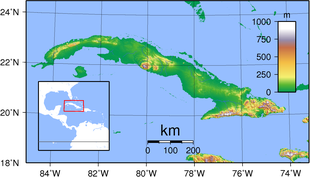
Cuba is an archipelago of 4,195 islands, cays and islets located in the northern Caribbean Sea at the confluence with the Gulf of Mexico and the Atlantic Ocean. It lies between latitudes 19° and 24°N, and longitudes 74° and 85°W. Florida (Key West, Florida) is about 150 km (93 miles) across the Straits of Florida to the north and northwest, and The Bahamas (Cay Lobos) 22.5 km (14 mi) to the north. Mexico lies 210 km (130.5 mi) west across the Yucatán Channel (to the closest tip of Cabo Catoche in the State of Quintana Roo).
Haiti is 77 km (47.8 mi) east and Jamaica 140 km (87 mi) south. Cuba is the principal island, surrounded by four smaller groups of islands: the Colorados Archipelago on the northwestern coast, the Sabana-Camagüey Archipelago on the north-central Atlantic coast, the Jardines de la Reina on the south-central coast and the Canarreos Archipelago on the southwestern coast.

The main island, named Cuba, is 1,250 km (780 mi) long, constituting most of the nation's land area (104,338 km2 or 40,285 sq mi) and is the largest island in the Caribbean and 17th-largest island in the world by land area. The main island consists mostly of flat to rolling plains apart from the Sierra Maestra mountains in the southeast, whose highest point is Pico Turquino (1,974 m or 6,476 ft).
The second-largest island is Isla de la Juventud (Isle of Youth) in the Canarreos archipelago, with an area of 2,204 km2 (851 sq mi). Cuba has an official area (land area) of 109,884 km2 (42,426 sq mi). Its area is 110,860 km2 (42,803 sq mi) including coastal and territorial waters.
Climate
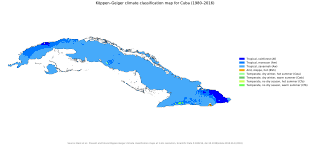
With the entire island south of the Tropic of Cancer, the local climate is tropical, moderated by northeasterly trade winds that blow year-round. The temperature is also shaped by the Caribbean current, which brings in warm water from the equator. This makes the climate of Cuba warmer than that of Hong Kong, which is at around the same latitude as Cuba but has a subtropical rather than a tropical climate. In general (with local variations), there is a drier season from November to April, and a rainier season from May to October. The average temperature is 21 °C (70 °F) in January and 27 °C (81 °F) in July. The warm temperatures of the Caribbean Sea and the fact that Cuba sits across the entrance to the Gulf of Mexico combine to make the country prone to frequent hurricanes. These are most common in September and October.
Hurricane Irma hit the island on 8 September 2017, with winds of 260 km/h (72 m/s),[177] at the Camagüey Archipelago; the storm reached Ciego de Avila province around midnight and continued to pound Cuba the next day.[178] The worst damage was in the keys north of the main island. Hospitals, warehouses and factories were damaged; much of the north coast was without electricity. By that time, nearly a million people, including tourists, had been evacuated.[179] The Varadero resort area also reported widespread damage; the government believed that repairs could be completed before the start of the main tourist season.[180] Subsequent reports indicated that ten people had been killed during the storm, including seven in Havana, most during building collapses. Sections of the capital had been flooded.[180]
Biodiversity
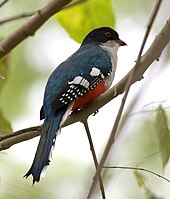
Cuba signed the Rio Convention on Biological Diversity on 12 June 1992, and became a party to the convention on 8 March 1994.[181] It has subsequently produced a National Biodiversity Strategy and Action Plan, with one revision, that the convention received on 24 January 2008.[182]
The country's fourth national report to the CBD contains a detailed breakdown of the numbers of species of each kingdom of life recorded from Cuba, the main groups being: animals (17,801 species), bacteria (270), chromista (707), fungi, including lichen-forming species (5844), plants (9107) and protozoa (1440).[183] The native bee hummingbird or zunzuncito is the world's smallest known bird, with a length of 55 mm (2+1⁄8 in). The Cuban trogon or tocororo is the national bird of Cuba and an endemic species. Hedychium coronarium, named mariposa in Cuba, is the national flower.[184]
Cuba is home to six terrestrial ecoregions: Cuban moist forests, Cuban dry forests, Cuban pine forests, Cuban wetlands, Cuban cactus scrub, and Greater Antilles mangroves.[185] It had a 2019 Forest Landscape Integrity Index mean score of 5.4/10, ranking it 102nd globally out of 172 countries.[186]
According to a 2012 study, Cuba is the only country in the world to meet the conditions of sustainable development put forth by the WWF.[187]
Government and politics
The Republic of Cuba is one of the few socialist countries following the Marxist–Leninist ideology. The Constitution of 1976, which defined Cuba as a socialist republic, was replaced by the Constitution of 1992, which is "guided by the ideas of José Martí and the political and social ideas of Marx, Engels and Lenin."[188] The constitution describes the Communist Party of Cuba as the "leading force of society and of the state".[188] The political system in Cuba reflects the Marxist–Leninist concept of democratic centralism.[189]: 38
The First Secretary of the Communist Party of Cuba is the most senior position in the one-party state.[190] The First Secretary leads the Politburo and the Secretariat, making the office holder the most powerful person in Cuban government.[191] Members of both councils are elected by the National Assembly of People's Power.[188] The President of Cuba, who is also elected by the Assembly, serves for five years and since the ratification of the 2019 Constitution, there is a limit of two consecutive five-year terms.[188]

The People's Supreme Court serves as Cuba's highest judicial branch of government. It is also the court of last resort for all appeals against the decisions of provincial courts.
Cuba's national legislature, the National Assembly of People's Power (Asamblea Nacional de Poder Popular), is the supreme organ of power; 474 members serve five-year terms.[188] The assembly meets twice a year; between sessions legislative power is held by the 31 member Council of Ministers. Candidates for the Assembly are approved by public referendum. All Cuban citizens over 16 who have not been convicted of a criminal offense can vote.[192] Article 131 of the Constitution states that voting shall be "through free, equal and secret vote".[188] Article 136 states: "In order for deputies or delegates to be considered elected they must get more than half the number of valid votes cast in the electoral districts".[188]
There are elections in Cuba, but they are not considered democratic.[193][194] In elections for the National Assembly of People's Power there is only one candidate for each seat, and candidates are nominated by committees that are firmly controlled by the Communist Party.[195][196] Most legislative districts elect multiple representatives to the Assembly. Voters can select individual candidates on their ballot, select every candidate, or leave every question blank, with no option to vote against candidates.[197][198]
No political party is permitted to nominate candidates or campaign on the island, including the Communist Party.[199] The Communist Party of Cuba has held six party congress meetings since 1975. In 2011, the party stated that there were 800,000 members, and representatives generally constitute at least half of the Councils of state and the National Assembly. The remaining positions are filled by candidates nominally without party affiliation. Other political parties campaign and raise finances internationally, while activity within Cuba by opposition groups is minimal.
Cuba is considered an authoritarian regime according to The Economist's Democracy Index[200] and Freedom in the World reports.[201] More specifically, Cuba is considered a military dictatorship in the Democracy-Dictatorship Index, and has been described as "a militarized society"[202] with the armed forces having long been the most powerful institution in the country.[203]
In February 2013, President of the State Council Raúl Castro announced he would resign in 2018, ending his five-year term, and that he hopes to implement permanent term limits for future Cuban presidents, including age limits.[204]
After Fidel Castro died on 25 November 2016, the Cuban government declared a nine-day mourning period. During the mourning period, Cuban citizens were prohibited from playing loud music, partying, and drinking alcohol.[205]
Miguel Díaz-Canel was elected president on 18 April 2018 after the resignation of Raúl Castro. On 19 April 2021, Díaz-Canel became First Secretary of the Communist Party. He is the first non-Castro to be in such top position since the Cuban revolution of 1959.[206]
Administrative divisions
The country is subdivided into 15 provinces and one special municipality (Isla de la Juventud). These were formerly part of six larger historical provinces: Pinar del Río, Habana, Matanzas, Las Villas, Camagüey and Oriente. The present subdivisions closely resemble those of the Spanish military provinces during the Cuban Wars of Independence, when the most troublesome areas were subdivided. The provinces are divided into municipalities.
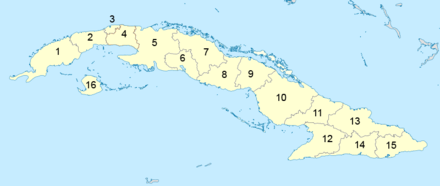
Foreign relations

Cuba has conducted a foreign policy that is uncharacteristic of such a minor, developing country.[207][208] Under Castro, Cuba was heavily involved in wars in Africa, Central America and Asia. Cuba supported Algeria in 1961–1965[209] and sent tens of thousands of troops to Angola during the Angolan Civil War.[210] Other countries that featured Cuban involvement include Ethiopia,[211][212] Guinea,[213] Guinea-Bissau,[214] Mozambique,[215] and Yemen.[216] Lesser known actions include the 1959 missions to the Dominican Republic.[217] The expedition failed, but a prominent monument to its members was erected in their memory in Santo Domingo by the Dominican government, and they feature prominently at the country's Memorial Museum of the Resistance.[218]
In 2008, the European Union (EU) and Cuba agreed to resume full relations and cooperation activities.[219] Cuba is a founding member of the Bolivarian Alliance for the Americas.[220] At the end of 2012, tens of thousands of Cuban medical personnel worked abroad,[221] with as many as 30,000 doctors in Venezuela alone via the two countries' oil-for-doctors programme.[222]
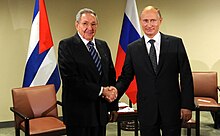
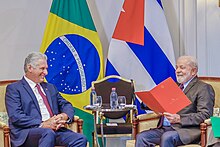
In 1996, the United States, then under President Bill Clinton, brought in the Cuban Liberty and Democratic Solidarity Act, better known as the Helms–Burton Act.[223][s] In 2009, United States President Barack Obama stated on 17 April, in Trinidad and Tobago that "the United States seeks a new beginning with Cuba",[225] and reversed the Bush Administration's prohibition on travel and remittances by Cuban-Americans from the United States to Cuba.[226] Five years later, an agreement between the United States and Cuba, popularly called the "Cuban thaw", brokered in part by Canada and Pope Francis, began the process of restoring international relations between the two countries. They agreed to release political prisoners and the United States began the process of creating an embassy in Havana.[227][228][229][230][231] This was realized on 30 June 2015, when Cuba and the U.S. reached a deal to reopen embassies in their respective capitals on 20 July 2015[232] and reestablish diplomatic relations.[233] Earlier in the same year, the White House announced that President Obama would remove Cuba from the American government's list of nations that sponsor terrorism,[234][235] which Cuba reportedly welcomed as "fair".[236] On 17 September 2017, the United States considered closing its Cuban embassy following mysterious medical symptoms experienced by its staff.[237] In the wake of the Russian invasion of Ukraine and the ongoing international isolation of Russia, Cuba emerged as one of the few countries that maintained friendly relations with the Russian Federation.[238][239] Cuban president Miguel Diaz-Canel visited Vladimir Putin in Moscow in November 2022, where the two leaders opened a monument of Fidel Castro, as well as speaking out against U.S. sanctions against Russia and Cuba.[240]
Embargo by the United States (1960–present)
Since 1960, the U.S. embargo on Cuba stands as one of the longest-running trade and economic measures in bilateral relations history, having endured for almost six decades. This action was initiated in response to a wave of nationalizations that impacted American properties valued at over US$1 billion, the then U.S.[241] President, Dwight Eisenhower, instated an embargo that prohibited all exports to Cuba, with the exception of medicines and certain foods.[241] This measure was intensified in 1962 under the administration of John F. Kennedy, extending the restrictions to Cuban imports, based on the Foreign Assistance Act approved by Congress in 1961.[241] During the Missile Crisis in 1962, the United States even imposed a naval blockade on Cuba, but this was lifted following the resolution of the crisis. The embargo, however, remained in place and has been modified on several occasions over the years.[241]
The Cuban Democracy Act of 1992 states that sanctions will continue "so long as it continues to refuse to move toward democratization and greater respect for human rights".[242][non-primary source needed] American diplomat Lester D. Mallory wrote an internal memo on April 6, 1960, arguing in favor of an embargo: "The only foreseeable means of alienating internal support is through disenchantment and disaffection based on economic dissatisfaction and hardship. [...] to decrease monetary and real wages, to bring about hunger, desperation and overthrow of government."[243][244] The UN General Assembly has passed a resolution every year since 1992 condemning the embargo and stating that it violates the Charter of the United Nations and international law.[245] Cuba considers the embargo a human rights violation.[246]

The impact and effectiveness of the embargo have been subjects of intense debate. While some argue it has been "extraordinarily porous" and isn't the primary cause of Cuba's economic hardships, others see it as a pressure mechanism aimed at driving change in the Cuban government.[241] According to Arturo Lopez Levy, a professor of international relations, it would be more appropriate to refer to the measure as a "blockade" or "siege", as it goes beyond mere trade restrictions.[241] Other critics of the Cuban government argue that the embargo has been used by the government as an excuse to justify its own economic and political shortcomings.[241]
On 17 December 2014, United States President Barack Obama announced the re-establishment of diplomatic relations with Cuba, pushing for Congress to put an end to the embargo,[247] as well as the United States-run Guantanamo Bay detention camp. These diplomatic improvements were later reversed by the Trump Administration, which enacted new rules and re-enforced the business and travel restrictions which were loosened by the Obama Administration.[248] These sanctions were inherited and strengthened by the Biden Administration.[249]
Despite the embargo, Cuba has maintained trade relations with other countries.[241] According to 2019 data, China stands as Cuba's main trading partner, followed by countries such as Spain, the Netherlands, Germany, and Cyprus. Cuba's main exports include tobacco, sugar, and alcoholic beverages, while it primarily imports chicken meat, wheat, corn, and condensed milk.[241]
Military
As of 2018[update], Cuba spent about US$91.8 million on its armed forces or 2.9% of its GDP.[250] In 1985, Cuba devoted more than 10% of its GDP to military expenditures.[141] During the Cold War, Cuba built up one of the largest armed forces in Latin America, second only to that of Brazil.[251]
From 1975 until the late 1980s, Soviet military assistance enabled Cuba to upgrade its military capabilities. After the loss of Soviet subsidies, Cuba scaled down the numbers of military personnel, from 235,000 in 1994 to about 49,000 in 2021.[252][253]
In 2017, Cuba signed the UN treaty on the Prohibition of Nuclear Weapons.[254]
Cuba is the 98th most peaceful country in the world, according to the 2024 Global Peace Index.[255]
Law enforcement
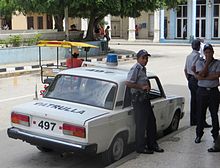
All law enforcement agencies are maintained under Cuba's Ministry of the Interior, which is supervised by the Revolutionary Armed Forces. In Cuba, citizens can receive police assistance by dialing "106" on their telephones.[256] The police force, which is referred to as "Policía Nacional Revolucionaria" or PNR is then expected to provide help. The Cuban government also has an agency called the Intelligence Directorate that conducts intelligence operations and maintains close ties with the Russian Federal Security Service.[257] The US Justice Department considers Cuba a significant counterintelligence threat.[258]
Civilians are also involved in law enforcement, in a limited capacity. The Committees for the Defense of the Revolution are an official neighborhood watch organization, made up of dedicated citizens who monitor their neighbors.[259] Membership is not selective, but leading members are approved by the Cuban Communist Party.[260]
Human rights
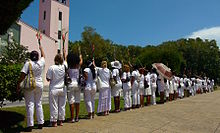
In 2003, the European Union (EU) accused the Cuban government of "continuing flagrant violation of human rights and fundamental freedoms".[261] As of 2009,[update] it has continued to call regularly for social and economic reform in Cuba, along with the unconditional release of all political prisoners.[262]
Cuba was ranked 19th by the number of imprisoned journalists of any nation in 2021[update] according to various sources, including the Committee to Protect Journalists and Human Rights Watch.[263][264] Cuba ranks 171st out of 180 on the 2020[update] World Press Freedom Index.[265]
In July 2010, the unofficial Cuban Human Rights Commission said there were 167 political prisoners in Cuba, a fall from 201 at the start of the year. The head of the commission stated that long prison sentences were being replaced by harassment and intimidation.[266]
Economy
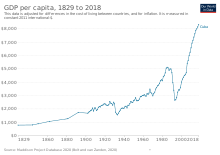
The Cuban state asserts its adherence to socialist principles in organizing its largely state-controlled planned economy. Most of the means of production are owned and run by the government and most of the labor force is employed by the state. Recent years have seen a trend toward more private sector employment. By 2006, public sector employment was 78% and private sector 22%, compared to 91.8% to 8.2% in 1981.[267] Government spending is 78.1% of GDP.[268] Since the early 2010s, following the initial market reforms, it has become popular to describe the economy as being, or moving toward, market socialism.[269][270][271] Any firm that hires a Cuban must pay the Cuban government, which in turn pays the employee in Cuban pesos.[272] The average monthly wage as of July 2013[update] was 466 Cuban pesos—about US$19.[273] However, after a reform in January 2021, the minimum wage is about 2100 CUP (US$18) and the median wage is about 4000 CUP (US$33).[citation needed]
Cuba had Cuban pesos (CUP) set at par with the US dollar before 1959.[273] Every Cuban household has a ration book (known as libreta) entitling it to a monthly supply of food and other staples, which are provided at nominal cost.[274]
According to the Havana Consulting Group, in 2014, remittances to Cuba amounted to US$3,129 million, the seventh highest in Latin America.[275] In 2019, remittances had grown to US$6,616 million, but dropped down to US$1,967 million in 2020, due to the COVID-19 pandemic.[276] The pandemic has also devastated Cuba's tourist industry, which along with a tightening of U.S. sanctions, has led to large increase in emigration among younger working-age Cubans. It has been described as a crisis that is "threatening the stability" of Cuba, which "already has one of the hemisphere’s oldest populations".[277] According to a controversial 2023 report by the Cuban Observatory of Human Rights (OCDH), 88% of Cuban citizens live in extreme poverty. The report stated that Cubans were concerned about food security and the difficulty in acquiring basic goods.[278]
According to the World Bank, Cuba's GDP per capita was $9,500 as of 2020.[279] But according to the CIA World Factbook, it was $12,300 as of 2016.[280] The United Nations Development Programme gave Cuba a Human Development Index (HDI) of 0.764 in 2021.[281] The same United Nations agency estimated the country's Multidimensional Poverty Index of 0.003 in 2023.[282]
In 2005, Cuba had exports of US$2.4 billion, ranking 114 of 226 world countries, and imports of US$6.9 billion, ranking 87 of 226 countries.[283] Its major export partners are Canada 17.7%, China 16.9%, Venezuela 12.5%, Netherlands 9%, and Spain 5.9% (2012).[284] Cuba's major exports are sugar, nickel, tobacco, fish, medical products, citrus fruits, and coffee;[284] imports include food, fuel, clothing, and machinery. Cuba presently holds debt in an amount estimated at $13 billion,[285] approximately 38% of GDP.[286]
According to The Heritage Foundation, Cuba is dependent on credit accounts that rotate from country to country.[287] Cuba's prior 35% supply of the world's export market for sugar has declined to 10% due to a variety of factors, including a global sugar commodity price drop that made Cuba less competitive on world markets.[288] It was announced in 2008 that wage caps would be abandoned to improve the nation's productivity.[289]
Cuba's leadership has called for reforms in the country's agricultural system. In 2008, Raúl Castro began enacting agrarian reforms to boost food production, as at that time 80% of food was imported. The reforms aim to expand land use and increase efficiency.[290] Venezuela supplies Cuba with an estimated 110,000 barrels (17,000 m3) of oil per day in exchange for money and the services of some 44,000 Cubans, most of them medical personnel, in Venezuela.[291][292]
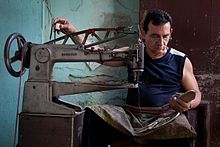
In 2010[update], Cubans were allowed to build their own houses. According to Raúl Castro, they could now improve their houses, but the government would not endorse these new houses or improvements.[293] There is virtually no homelessness in Cuba,[294][295] and 85% of Cubans own their homes[296] and pay no property taxes or mortgage interest. Mortgage payments may not exceed 10% of a household's combined income.[citation needed].
On 2 August 2011, The New York Times reported that Cuba reaffirmed its intent to legalize "buying and selling" of private property before the year's end. According to experts, the private sale of property could "transform Cuba more than any of the economic reforms announced by President Raúl Castro's government".[297] It would cut more than one million state jobs, including party bureaucrats who resist the changes.[298] The reforms created what some call "New Cuban Economy".[299][300] In October 2013, Raúl said he intended to merge the two currencies, but as of August 2016[update], the dual currency system remains in force.
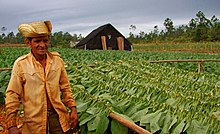
In 2016, the Miami Herald wrote, "... about 27 percent of Cubans earn under $50 per month; 34 percent earn the equivalent of $50 to $100 per month; and 20 percent earn $101 to $200. Twelve percent reported earning $201 to $500 a month; and almost 4 percent said their monthly earnings topped $500, including 1.5 percent who said they earned more than $1,000."[301]
In May 2019, Cuba imposed rationing of staples such as chicken, eggs, rice, beans, soap and other basic goods. (Some two-thirds of food in the country is imported.) A spokesperson blamed the increased U.S. trade embargo although economists believe that an equally important problem is the massive decline of aid from Venezuela and the failure of Cuba's state-run oil company which had subsidized fuel costs.[302]
In June 2019, the government announced an increase in public sector wages of about 300%, specifically for teachers and health personnel.[303] In October, the government allowed stores to purchase house equipment and similar items, using international currency, and send it to Cuba by emigration. The leaders of the government recognized that the new measures were unpopular but necessary to contain the capital flight to other countries as Panamá where Cuban citizens traveled and imported items to resell on the island. Other measures included allowing private companies to export and import, through state companies, resources to produce products and services in Cuba.
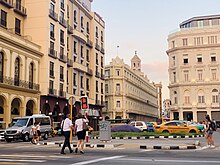
On January 1, 2021, Cuba's dual currency system was formally ended, and the convertible Cuban peso (CUC) was phased out, leaving the Cuban peso (CUP) as the country's sole currency unit. Cuban citizens had until June 2021 to exchange their CUCs. However, this devalued the Cuban peso and caused economic problems for people who had been previously paid in CUCs, particularly workers in the tourism industry.[304][305][306] Also, in February, the government dictated new measures to the private sector, with prohibitions for only 124 activities,[307] in areas like national security, health and educational services.[308] The wages were increased again, between 4 and 9 times, for all the sectors. Also, new facilities were allowed to the state companies, with much more autonomy.[305]
The first problem with the new reform, in terms of public opinion, were electricity prices, but that was amended quickly. Other measures corrected were in the prices for private farmers.[citation needed] In July 2020, Cuba opened new stores accepting only foreign currency while simultaneously eliminating a special tax on the U.S. dollar[309] to combat an economic crisis arising initially due to economic sanctions imposed by the Trump administration,[310] then later worsened by a lack of tourism during the coronavirus pandemic. These economic sanctions have since been sustained by the Biden administration.[311]
Resources
Cuba's natural resources include sugar, tobacco, fish, citrus fruits, coffee, beans, rice, potatoes, and livestock. Cuba's most important mineral resource is nickel, with 21% of total exports in 2011.[312] The output of Cuba's nickel mines that year was 71,000 tons, approaching 4% of world production.[313] As of 2013[update] its reserves were estimated at 5.5 million tons, over 7% of the world total.[313] Sherritt International of Canada operates a large nickel mining facility in Moa. Cuba is also a major producer of refined cobalt, a by-product of nickel mining.[314]
Oil exploration in 2005 by the US Geological Survey revealed that the North Cuba Basin could produce about 4.6 billion barrels (730,000,000 m3) to 9.3 billion barrels (1.48×109 m3) of oil. In 2006, Cuba started to test-drill these locations for possible exploitation.[315]
Tourism

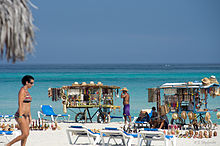
Tourism was initially restricted to enclave resorts where tourists would be segregated from Cuban society, referred to as "enclave tourism" and "tourism apartheid".[316] Contact between foreign visitors and ordinary Cubans were de facto illegal between 1992 and 1997.[317] The rapid growth of tourism during the Special Period had widespread social and economic repercussions in Cuba, and led to speculation about the emergence of a two-tier economy.[318]
1.9 million tourists visited Cuba in 2003, predominantly from Canada and the European Union, generating revenue of US$2.1 billion.[319] Cuba recorded 2,688,000 international tourists in 2011, the third-highest figure in the Caribbean (behind the Dominican Republic and Puerto Rico).[320]
The medical tourism sector caters to thousands of European, Latin American, Canadian, and American consumers every year.[citation needed]
A study in 2018 indicated that Cuba has a potential for mountaineering activity, and that mountaineering could be a key contributor to tourism, along with other activities, e.g. biking, diving, caving. Promoting these resources could contribute to regional development, prosperity, and well-being.[321]
The Cuban Justice minister downplays allegations of widespread sex tourism.[322] According to a Government of Canada travel advice website, "Cuba is actively working to prevent child sex tourism, and a number of tourists, including Canadians, have been convicted of offenses related to the corruption of minors aged 16 and under. Prison sentences range from 7 to 25 years."[323]
Some tourist facilities were extensively damaged on 8 September 2017 when Hurricane Irma hit the island. The storm made landfall in the Camagüey Archipelago; the worst damage was in the keys north of the main island, however, and not in the most significant tourist areas.[179]
Transport
Demographics
According to the official census of 2010, Cuba's population was 11,241,161, comprising 5,628,996 men and 5,612,165 women.[324] Its birth rate (9.88 births per thousand population in 2006)[325] is one of the lowest in the Western Hemisphere. Although the country's population has grown by about four million people since 1961, the rate of growth slowed during that period, and the population began to decline in 2006, due to the country's low fertility rate (1.43 children per woman) coupled with emigration.[326]
Largest cities
| Rank | Name | Province | Pop. | ||||||
|---|---|---|---|---|---|---|---|---|---|
 Havana  Santiago de Cuba |
1 | Havana | Havana | 2,131,480 |  Camagüey  Holguín | ||||
| 2 | Santiago de Cuba | Santiago de Cuba | 433,581 | ||||||
| 3 | Camagüey | Camagüey | 308,902 | ||||||
| 4 | Holguín | Holguín | 297,433 | ||||||
| 5 | Santa Clara | Villa Clara | 216,854 | ||||||
| 6 | Guantánamo | Guantánamo | 216,003 | ||||||
| 7 | Victoria de Las Tunas | Las Tunas | 173,552 | ||||||
| 8 | Bayamo | Granma | 159,966 | ||||||
| 9 | Cienfuegos | Cienfuegos | 151,838 | ||||||
| 10 | Pinar del Río | Pinar del Río | 145,193 | ||||||
Ethnoracial groups

Cuba's population is multiethnic, reflecting its complex colonial origins. Intermarriage between diverse groups is widespread, and consequently there is some discrepancy in reports of the country's racial composition: whereas the Institute for Cuban and Cuban-American Studies at the University of Miami determined that 62% of Cubans are black using the one drop rule,[329] the 2002 Cuban census found that a similar proportion of the population, 65.05%, was white.
In fact, the Minority Rights Group International determined that "An objective assessment of the situation of Afro-Cubans remains problematic due to scant records and a paucity of systematic studies both pre- and post-revolution. Estimates of the percentage of people of African descent in the Cuban population vary enormously, ranging from 34% to 62%".[330]
A 2014 study found that, based on ancestry informative markers (AIM), autosomal genetic ancestry in Cuba is 72% European, 20% African, and 8% Indigenous.[331]
Asians make up about 1% of the population, and are largely of Chinese ancestry, followed by Japanese and Filipino.[332][333] Many are descendants of farm laborers brought to the island by Spanish and American contractors during the 19th and early 20th century.[334] The current recorded number of Cubans with Chinese ancestry is 114,240.[335]
Afro-Cubans are descended primarily from the Yoruba people, Bantu people from the Congo basin, Kalabari tribe and Arará from the Dahomey, as well as several thousand North African refugees, most notably the Sahrawi Arabs of Western Sahara.[336]
Migration
Immigration
Immigration and emigration have played a prominent part in Cuba's demographic profile. Between the 18th and early 20th century, large waves of Canarian, Catalan, Andalusian, Galician, and other Spanish people immigrated to Cuba. Between 1899 and 1930 alone, close to a million Spaniards entered the country, though many would eventually return to Spain.[337] Other prominent immigrant groups included French,[338] Portuguese, Italian, Russian, Dutch, Greek, British, and Irish, as well as small number of descendants of U.S. citizens who arrived in Cuba in the late 19th and early 20th centuries. As of 2015, the foreign-born population in Cuba was 13,336 inhabitants per the World Bank data.[339]
Emigration
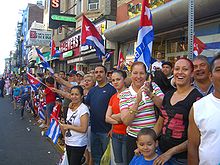
Post-revolution Cuba has been characterized by significant levels of emigration, which has led to a large and influential diaspora community. During the three decades after January 1959, more than one million Cubans of all social classes—constituting 10% of the total population—emigrated to the United States, a proportion that matches the extent of emigration to the U.S. from the Caribbean as a whole during that period.[340][341][342][343][344] Prior to 13 January 2013, Cuban citizens could not travel abroad, leave or return to Cuba without first obtaining official permission along with applying for a government-issued passport and travel visa, which was often denied.[345] Those who left the country typically did so by sea, in small boats and fragile rafts.
On 9 September 1994, the U.S. and Cuban governments agreed that the U.S. would grant at least 20,000 visas annually in exchange for Cuba's pledge to prevent further unlawful departures on boats.[346]
In 2023, Cuba is undergoing its most severe socioeconomic crisis since the fall of the Soviet Union, leading to a record number of Cubans fleeing the island.[347] In 2022 alone, the number of Cubans trying to enter the United States, primarily through the Mexican border, surged from 39,000 in 2021 to over 224,000. Many have resorted to selling their homes at very low prices to afford one-way flights to Nicaragua, hoping to travel through Mexico to reach the U.S.[347] For those remaining among the island's 11 million inhabitants, life grows increasingly desperate. Internal migration has led to overpopulation in the capital, Havana, resulting in people living in makeshift shelters or overcrowded buildings, some of which are on the brink of collapse. The island's persistent shortages of food and medicine can be attributed to the U.S. trade embargo in place since 1962 and stringent government control over the economy since 1959. Regular power outages harken back to the early 1990s, a time when Soviet subsidies ended, plunging the island into economic hardship.[347]
Cuba's "Special Period" saw the country relying heavily on foreign tourism and the earnings of nationals working abroad. The pandemic, however, severely affected this revenue stream, decreasing the number of tourists by 75% in 2020. Monetary reforms in 2021 introduced shocks of inflation, further exacerbating the country's food scarcity and boosting the black market's prominence.[347] Despite the increasing hardships, the Cuban spirit remains resilient. Access to the internet since 2018 and widespread use of social media have fueled calls for political and economic liberalization. The power of the internet was evident during the Cuban protests of 2021, which were promptly suppressed by the police, with many prominent artists and bloggers detained.[347]
As of 2013 the top emigration destinations were the United States, Spain, Italy, Puerto Rico, and Mexico.[348] Following a tightening of U.S. sanctions and damage to the tourist industry by the COVID-19 pandemic, emigration has accelerated. In 2022, more than 2% of the population (almost 250,000 Cubans out of 11 million) migrated to the United States, and thousands more went to other countries, a number "larger than the 1980 Mariel boatlift and the 1994 Cuban rafter crisis combined", which were Cuba's previous largest migration events.[277]
Languages
The official language of Cuba is Spanish and the vast majority of Cubans speak it. Spanish as spoken in Cuba is known as Cuban Spanish and is a form of Caribbean Spanish. Lucumí, a dialect of the West African language Yoruba, is also used as a liturgical language by practitioners of Santería,[349] and so only as a second language.[350] Haitian Creole is the second-most spoken language in Cuba, and is spoken by Haitian immigrants and their descendants.[351] Other languages spoken by immigrants include Galician and Corsican.[352]
Religion

In 2010, the Pew Forum estimated that religious affiliation in Cuba is 59.2% Christian, 23% unaffiliated, 17.4% folk religion (such as santería), and the remaining 0.4% consisting of other religions.[353] In a 2015 survey sponsored by Univision, 44% of Cubans said they were not religious and 9% did not give an answer while only 34% said they were Christian.[354]
Cuba is officially a secular state. Religious freedom increased through the 1980s,[355] with the government amending the constitution in 1992 to drop the state's characterization as atheistic.[356]
Roman Catholicism is the largest religion, with its origins in Spanish colonization. Despite less than half of the population identifying as Catholics in 2006, it nonetheless remains the dominant faith.[287] Pope John Paul II and Pope Benedict XVI visited Cuba in 1998 and 2011, respectively, and Pope Francis visited Cuba in September 2015.[357][358] Prior to each papal visit, the Cuban government pardoned prisoners as a humanitarian gesture.[359][360]
The government's relaxation of restrictions on house churches in the 1990s led to an explosion of Pentecostalism, with some groups claiming as many as 100,000 members. However, Evangelical Protestant denominations, organized into the umbrella Cuban Council of Churches, remain much more vibrant and powerful.[361]
The religious landscape of Cuba is also strongly defined by syncretisms of various kinds. Christianity is often practiced in tandem with Santería, a mixture of Catholicism and mostly African faiths, which include a number of cults. La Virgen de la Caridad del Cobre (the Virgin of Cobre) is the Catholic patroness of Cuba, and a symbol of Cuban culture. In Santería, she has been syncretized with the goddess Oshun. A breakdown of the followers of Afro-Cuban religions showed that most practitioners of Palo Mayombe were black and dark brown-skinned, most practitioners of Vodú were medium brown and light brown-skinned, and most practitioners of Santeria were light brown and white-skinned.[362]
Cuba also hosts small communities of Jews (500 in 2012), Muslims, and members of the Baháʼí Faith.[363]
Several well-known Cuban religious figures have operated outside the island, including the humanitarian and author Jorge Armando Pérez.
Education
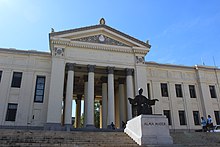
The University of Havana was founded in 1728 and there are a number of other well-established colleges and universities. In 1957, just before Castro came to power, the literacy rate was as low as fourth in the region at almost 80% according to the United Nations, yet higher than in Spain.[111] Castro created an entirely state-operated system and banned private institutions. School attendance is compulsory from ages six to the end of basic secondary education (normally at age 15), and all students, regardless of age or gender, wear school uniforms with the color denoting grade level. Primary education lasts for six years, secondary education is divided into basic and pre-university education.[364] Cuba's literacy rate of 99.8 percent[284][365] is the tenth-highest globally, largely due to the provision of free education at every level.[366] Cuba's high school graduation rate is 94 percent.[367]
Higher education is provided by universities, higher institutes, higher pedagogical institutes, and higher polytechnic institutes. The Cuban Ministry of Higher Education operates a distance education program that provides regular afternoon and evening courses in rural areas for agricultural workers. Education has a strong political and ideological emphasis, and students progressing to higher education are expected to have a commitment to the goals of Cuba.[364] Cuba has provided free education to foreign nationals from disadvantaged backgrounds at the Latin American School of Medicine.[368][369]
According to the Webometrics Ranking of World Universities, the top-ranking universities in the country are Universidad de la Habana (1680th worldwide), Instituto Superior Politécnico José Antonio Echeverría (2893rd) and the University of Santiago de Cuba (3831st).[370]
Health

After the revolution, Cuba established a free public health system.[30]
Cuba's life expectancy at birth is 79.87 years (77.53 for males and 82.35 for females). This ranks Cuba 59th in the world and 4th in the Americas, behind Canada, Chile and the United States.[371] Infant mortality declined from 32 infant deaths per 1,000 live births in 1957, to 10 in 1990–95,[372] 6.1 in 2000–2005 and 5.13 in 2009.[365][284] Historically, Cuba has ranked high in numbers of medical personnel and has made significant contributions to world health since the 19th century.[111] Today, Cuba has universal health care and despite persistent shortages of medical supplies, there is no shortage of medical personnel.[373] Primary care is available throughout the island and infant and maternal mortality rates compare favorably with those in developed nations.[373] That an impoverished nation like Cuba has health outcomes rivaling the developed world is referred to by researchers as the Cuban Health Paradox.[374] Cuba ranks 30th on the 2019 Bloomberg Healthiest Country Index, the highest ranking of a developing country.[375] The Cuban healthcare system, renowned for its medical services, has emphasized the export of health professionals through international missions, aiding global health efforts.[376] However, while these missions generate significant revenue and serve as a tool for political influence, domestically, Cuba faces challenges including medication shortages and disparities between medical services for locals and foreigners.[376] Despite the income from these missions, only a small fraction of the national budget has been allocated to public health, underscoring contrasting priorities within the nation's healthcare strategy.[376]
Disease and infant mortality increased in the 1960s immediately after the revolution, when half of Cuba's 6,000 doctors left the country.[377] Recovery occurred by the 1980s,[98] and the country's health care has been widely praised.[378] The Communist government stated that universal health care was a priority of state planning and progress was made in rural areas.[379] After the revolution, the government increased rural hospitals from one to 62.[30] Like the rest of the Cuban economy, medical care suffered from severe material shortages following the end of Soviet subsidies in 1991, and a tightening of the U.S. embargo in 1992.[380]
Challenges include low salaries for doctors,[31] poor facilities, poor provision of equipment, and the frequent absence of essential drugs.[32]
Cuba has the highest doctor-to-population ratio in the world and has sent thousands of doctors to more than 40 countries around the world.[381] According to the World Health Organization, Cuba is "known the world over for its ability to train excellent doctors and nurses who can then go out to help other countries in need".[382] As of September 2014[update], there are around 50,000 Cuban-trained health care workers aiding 66 nations.[383] Cuban physicians have played a leading role in combating the Ebola virus epidemic in West Africa.[384] Preventative medicine is very important within the Cuban medical system, which provides citizens with easy to obtain regular health checks.[30]
Import and export of pharmaceutical drugs is done by the Quimefa Pharmaceutical Business Group (FARMACUBA) under the Ministry of Basic Industry (MINBAS). This group also provides technical information for the production of these drugs.[385] Isolated from the West by the US embargo, Cuba developed the successful lung cancer vaccine, Cimavax, which is now available to US researchers for the first time, along with other novel Cuban cancer treatments. The vaccine has been available for free to the Cuban population since 2011.[386] According to Roswell Park Comprehensive Cancer Center CEO Candace Johnson: "They've had to do more with less, so they've had to be even more innovative with how they approach things. For over 40 years, they have had a preeminent immunology community."[387] During the thaw in Cuba–U.S. relations starting in December 2014 under the Obama administration, a growing number of U.S. lung cancer patients traveled to Cuba to receive vaccine treatment. The end of the thaw under the Trump Administration has resulted in a tightening of travel restrictions, making it harder for U.S. citizens to travel to Cuba for treatment.[388]
In 2015, Cuba became the first country to eradicate mother-to-child transmission of HIV and syphilis,[389] a milestone hailed by the World Health Organization as "one of the greatest public health achievements possible".[390]
Diet and Nutrition in the Cuban Household
The traditional diet in Cuban households has raised international concerns due to its lack of micronutrients and diversity. According to the World Food Programme (WFP), an entity of the United Nations, the average diet in Cuba lacks adequate nutritional quality. This is attributed to various factors, including limited availability of nutrient-rich foods, socioeconomic issues, and poor dietary habits.[34] The WFP's annual report on Cuba supports previous testimonies and evidence, pointing to a concerning situation. Even though the country has rolled out food subsidy programs, many backed by the WFP, the populace's diet remains nutritionally insufficient. Specifically, rationed food covers only a small percentage of the daily energy, protein, and fat requirements for the population aged 14 to 60.[34]
Such deficiencies have led to health issues like overweight and obesity, largely due to a diet high in sugars and salts. Additionally, there is a significant disparity in accessing proper nutrition. Individuals without access to foreign currencies and remittances are the most affected. The inadequacy of the minimum wage to meet recommended nutritional requirements is another concern highlighted in the report.[34] The political and socioeconomic landscape has influenced this scenario. The implementation of the "Tarea Ordenamiento," an economic reform that removed many food subsidies, has spurred alarming inflation, intensifying the shortage of basic foods like cereals, vegetables, dairy, and meat. As a result, Cuban households spend between 55% and 65% of their income on food, a proportion deemed disproportionate compared to international standards.[34]
Nevertheless, the report acknowledges the Cuban government's efforts in areas like social protection and universal access to basic services. It highlights Cuba's position in the Human Development Report 2021-2022 and the extensive COVID-19 vaccination coverage.[34] To address food security challenges, the WFP has enhanced its collaboration with Cuban authorities. In 2022, the organization procured essential foods and macronutrients worth $10.7 million in response to alarming figures about anemia prevalence in infants.[34]
Amid this nutritional crisis, international interventions and collaborations are anticipated to alleviate the food and nutrition issues plaguing the Cuban populace.[34]
Culture
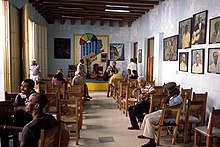
Cuban culture is influenced by its melting pot of cultures, primarily those of Spain, West Africa and the Indigenous Guanahatabey and Taínos of Cuba. After the 1959 revolution, the government started a national literacy campaign, offered free education to all and established rigorous sports, ballet, and music programs.[391]
Architecture
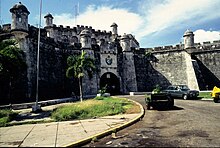
Architecture in Cuba was mainly manifested during the colonial period. It brought the culture of Spain with its Baroque influence. The first villas (settlements) were constituted by a church surrounded by several houses. These houses had an interior or central courtyard and were covered with grilles. There are magnificent religious buildings such as the Basílica de San Francisco of Havana. In addition, large forts were built for defense, preventing the attack of pirates and buccaneers. There are several old historic centers in Cuba that were built during the Spanish colonial period, the most remarkable are the four cities inscribed as World Heritage Sites by UNESCO, Havana, Camagüey, Cienfuegos and Trinidad, which has great architectural bastions of all currents and trends from Baroque, Neoclassical to eclectic art, and other preserved colonial towns such as Santiago de Cuba, Matanzas or Remedios.
During the Republican period, large buildings were built, such as the Capitol, modeled after the one in Washington, and other large buildings such as the Focsa and the Habana Hilton, later the Habana Libre. One of the most outstanding Cuban architects of the second half of the 20th century was Antonio Quintana Simonetti.
After the triumph of the Revolution, architecture received a strong Soviet influence with its desire for symmetry and space saving, and entire new neighborhoods were built in the style of the working-class quarters of Moscow or Minsk. When the Berlin Wall fell, architecture received more diverse currents and there was a boom in 5 star hotels with impressive glass and steel facades in the style of modern skyscrapers in Manhattan or other Latin American metropolises such as Mexico City or Caracas.
Literature
Cuban literature began to find its voice in the early 19th century. Dominant themes of independence and freedom were exemplified by José Martí, who led the Modernist movement in Cuban literature. Writers such as Nicolás Guillén and José Z. Tallet focused on literature as social protest. The poetry and novels of Dulce María Loynaz and José Lezama Lima have been influential. Romanticist Miguel Barnet, who wrote Everyone Dreamed of Cuba, reflects a more melancholy Cuba.[392]
Alejo Carpentier was important in the magic realism movement. Writers such as Reinaldo Arenas, Guillermo Cabrera Infante, and Daína Chaviano, Pedro Juan Gutiérrez, Zoé Valdés, Guillermo Rosales and Leonardo Padura have earned international recognition in the post-revolutionary era, though many of these have felt compelled to continue their work in exile due to ideological control of media by the Cuban authorities. However, some Cuban writers continue living and writing in Cuba, including Nancy Morejón.[393]
Music
Cuban music is very rich and is the most commonly known expression of Cuban culture. The central form of this music is son, which has been the basis of many other musical styles like "Danzón de nuevo ritmo", mambo, cha-cha-chá and salsa music. Rumba ("de cajón o de solar") music originated in the early Afro-Cuban culture, mixed with Spanish elements of style.[394] The Tres was invented in Cuba from Spanish cordophone instruments models (the instrument is actually a fusion of elements from the Spanish guitar and lute). Other traditional Cuban instruments are of African origin, Taíno origin, or both, such as the maracas, güiro, marímbula and various wooden drums including the mayohuacán.
Popular Cuban music of all styles has been enjoyed and praised widely across the world. Cuban classical music, which includes music with strong African and European influences, and features symphonic works as well as music for soloists, has received international acclaim thanks to composers like Ernesto Lecuona. Havana was the heart of the rap scene in Cuba when it began in the 1990s. In December 2012, the director of the Cuban Music Institute, Orlando Vistel, threatened to bar sexually explicit songs and music videos from public radio and television.[395]
Dance
Cuban culture encompasses a wide range of dance forms.[396] Danzón was the official musical genre and dance of Cuba.[397] Mambo music and dance developed originally in Cuba, with further significant developments by Cuban musicians in Mexico and the US. The cha-cha-cha is another dance of Cuban origin,[398] while the Cuban bolero originated in Santiago de Cuba in the last quarter of the 19th century.[399] Concert dance is supported by the government and includes internationally renowned companies such as the Ballet Nacional de Cuba.[400]
Salsa dancing originated in Cuba and Cuban salsa is danced around the world.
Media
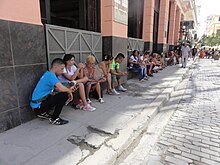
ETECSA opened 118 cybercafes across the country in 2013.[401] The government of Cuba provides an online encyclopedia website called EcuRed that operates in a "wiki" format.[402] Internet access is controlled, and e-mail is closely monitored.[403]
Since 2018, access to Internet by mobile data is available. In 2019, 7.1 million Cubans could access the Internet.[404] The prices of connections, since[clarification needed] WiFi zones, or mobile data, or from houses through "Nauta Hogar" service have been decreasing, especially since the economic reform of January 2021, when all the salaries increased by at least 5 times, and the prices of Internet remain in the same point.[405][406] In 2021, it was reported that 7.7 million Cuban people have Internet access.[407] There were 6.14 million mobile connections in Cuba in January 2021.[407]
Cuisine
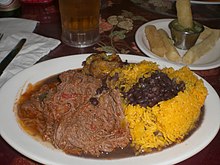
Cuban cuisine is a fusion of Spanish and Caribbean cuisines. Cuban recipes share spices and techniques with Spanish cooking, with some Caribbean influence in spice and flavor. Food rationing, which has been the norm in Cuba for the last four decades, restricts the common availability of these dishes.[408] The traditional Cuban meal is not served in courses; all food items are served at the same time.
The typical meal could consist of plantains, black beans and rice, ropa vieja (shredded beef), Cuban bread, pork with onions, and tropical fruits. Black beans and rice, referred to as moros y cristianos (or moros for short), and plantains are staples of the Cuban diet. Many of the meat dishes are cooked slowly with light sauces. Garlic, cumin, oregano, and bay leaves are the dominant spices.[citation needed]
Sports
Due to historical associations with the United States, many Cubans participate in sports that are popular in North America, rather than sports traditionally played in other Latin American nations. Baseball is the most popular. Other popular sports include volleyball, boxing, athletics, wrestling, basketball and water sports.[409] Cuba is a dominant force in amateur boxing, consistently achieving high medal tallies in major international competitions. Boxers Rances Barthelemy and Erislandy Lara defected to the U.S. and Mexico respectively.[410][411] Cuba also provides a national team that competes in the Olympic Games.[412] Jose R. Capablanca was a Cuban world chess champion from 1921 to 1927.
See also
Notes
- ^ Data represents racial self-identification from Cuba's 2012 national census
- ^ The most powerful political position is First Secretary of the Communist Party of Cuba, not President. The first secretary controls the Politburo and the Secretariat, Cuba's top decision-making bodies, making the officeholder de facto leader of Cuba.
- ^ /ˈkjuːbə/ KEW-bə, Spanish: [ˈkuβa]
- ^ Spanish: República de Cuba [reˈpuβlika ðe ˈkuβa]
- ^ After the French captured Havana in 1555, the governor's son, Francisco de Angulo, went to the Viceroyalty of New Spain.[53]
- ^ The French had recommended this to Spain, advising that declining to give up Florida could result in Spain losing New Spain and much of their territories on South American mainland in the future.[56] Many in Britain were disappointed, believing that Florida was a poor return for Cuba and Britain's other gains in the war.[56]
- ^ This was a much higher proportion of free blacks to slaves than in Virginia, for instance, or the other Caribbean islands. Historians such as Magnus Mõrner, who have studied slavery in Latin America, found that manumissions increased when slave economies were in decline, as in 18th-century Cuba and early 19th-century Maryland in the United States.[55][62]
- ^ By contrast, Virginia, with about the same number of blacks, had only 58,042 or 11% who were free; the rest were enslaved.[55]
- ^ While Céspedes retained civilian leadership, the military aspects of the Ten Years' War were under the leadership of the Dominican Máximo Gómez.[citation needed]
- ^ A group of Dominican exiles, led by Máximo Gómez, Luis Marcano, and Modesto Díaz, utilizing the experience they had gained in the Dominican Restoration War (1863–65), became instructors of military strategy and tactics. With reinforcements and guidance from the Dominicans, the Cubans defeated Spanish detachments, cut railway lines, and gained dominance over vast sections of the eastern portion of the island.[65] On 19 February 1874, Gómez and 700 other rebels marched westward from their eastern base and defeated 2,000 Spanish troops at El Naranjo. The Spaniards lost 100 killed and 200 wounded and the rebels a total of 150 killed and wounded.[66] The most significant rebel victory came at the Battle of Las Guasimas, 16–20 March 1874, when 2,050 rebels, led by Antonio Maceo and Gómez, defeated 5,000 Spanish troops with 6 cannons. The five-day battle cost the Spanish 1,037 casualties and the rebels 174 casualties.[66]
- ^ A battalion of 500 Chinese fought under the command of General Máximo Gómez in the 1874 Battle of Las Guasimas.[67]
- ^ A monument in Havana honors the Cuban Chinese who fell in the war.[68]
- ^ Spain sustained 200,000 casualties, mostly from disease; the rebels sustained 100,000–150,000 dead.[70]
- ^ Over the previous decades, five U.S. presidents—Polk, Pierce, Buchanan, Grant, and McKinley—had tried to buy the island of Cuba from Spain.[80][81]
- ^ The Battle of Santiago de Cuba, on 3 July 1898, was the largest naval engagement during the Spanish–American War, and resulted in the destruction of the Spanish Caribbean Squadron. Resistance in Santiago consolidated around Fort Canosa, while major battles between Spaniards and Americans took place at Las Guasimas on 24 June, and at El Caney and San Juan Hill on 1 July, after which the American advance ground to a halt. The Americans lost 81 killed and 360 wounded in taking El Caney, where the Spanish defenders lost 38 killed, 138 wounded and 160 captured. At San Juan, the Americans lost 216 killed and 1,024 wounded; Spanish losses were 58 killed, 170 wounded and 39 captured.[82] Spanish troops successfully defended Fort Canosa, allowing them to stabilize their line and bar the entry to Santiago. The Americans and Cubans began a brutal siege of the city, which surrendered on 16 July after the defeat of the Spanish Caribbean Squadron. Spain had sacrificed more of its sons to hold on to Cuba than she had in attempting to cling on to Mexico and South America,[83] and suffered over 62,000 dead in the Cuban War of Independence (1895–98).
- ^ Dominican Republic strongman Rafael Trujillo and Castro both supported attempts to overthrow each other. On 14 June 1959, a Cuban-supported invasion force[117] landed from an airplane at Constanza, Dominican Republic, only to be immediately massacred.[118] A week later, two yachts offloaded 186 invaders onto Chris-Craft launches for a landing on the North coast. Dominican Air Force pilots fired rockets from their Vampire Jets into the approaching launches, killing all but 30 men, who managed to make it to the beaches at Maimon and Estero Hondo. Trujillo ordered his son, Ramfis, to lead the hunt for the survivors, and soon they were captured. The leaders of the invasion were taken aboard a Dominican Air Force plane and then pushed out in mid-air, falling to their deaths.[119] Militant anti-Castro groups, funded by exiles, by the Central Intelligence Agency (CIA) and by Trujillo's Dominican government, carried out armed attacks and set up guerrilla bases in Cuba's mountainous regions. This led to the six-year Escambray rebellion (1959–65), which lasted longer and involved more soldiers than the Cuban Revolution.[120][121]
- ^ An estimated 5,000 Cubans were killed in action during the Angolan Civil War.[141]
- ^ The presence of a substantial number of blacks and mulattoes in the Cuban forces (40–50 percent in Angola) helped give teeth to Castro's campaign against racism and related prejudice like xenophobia.[147]
- ^ Roy's study was described as "systematic and fair" by Jorge Domínguez.[224]
References
- ^ "Cuban Peso Bills". Central Bank of Cuba. 2015. Archived from the original on 26 September 2018. Retrieved 14 February 2017.
- ^ "National symbols". Government of Cuba. Archived from the original on 15 January 2016. Retrieved 7 September 2009.
- ^ "Central America :: Cuba — The World Factbook – Central Intelligence Agency". Cia.gov. Archived from the original on 12 August 2021. Retrieved 28 September 2021.
- ^ "Cuba - The World Factbook". www.cia.gov. 6 October 2021. Archived from the original on 12 August 2021. Retrieved 19 January 2021.
- ^ "Constitution of Cuba" (PDF). constituteproject.org. National Assembly of People's Power. 10 April 2019. Archived (PDF) from the original on 28 February 2020. Retrieved 15 June 2023.
- ^ "New Cuban leadership reflects a rebranding of Castro dictatorship". Archived from the original on 4 June 2021. Retrieved 11 February 2024.
- ^ "Cuba". Central Intelligence Agency. 20 February 2023. Archived from the original on 12 August 2021. Retrieved 20 November 2023.
- ^ Torres, Nora Gámez (24 July 2024). "Cuba admits to massive emigration wave: a million people left in two years amid crisis". Miami Herald. Retrieved 13 August 2024.
- ^ "Cuba". The World Factbook (2024 ed.). Central Intelligence Agency. Retrieved 22 June 2023.
- ^ "Indicadores Demográficos por provincias y municipios 2022" (in Spanish). Oficina Nacional de Estadística e Information República de Cuba. Archived from the original on 14 March 2020. Retrieved 8 June 2023.
- ^ a b "World Bank GDP PPP 2015, 28 April 2017 PDF". Retrieved 18 January 2018.
- ^ "World Bank total population of Cuba in 2015 (GDP PPP divided by Population data)". Archived from the original on 11 November 2020. Retrieved 18 January 2018.
- ^ a b "Basic Data Selection". United Nations. Archived from the original on 20 September 2022. Retrieved 12 February 2024.
- ^ "Cuba grapples with growing inequality". Reuters. Archived from the original on 23 December 2015. Retrieved 21 July 2013.
- ^ "Human Development Report 2023/24" (PDF). United Nations Development Programme. 13 March 2024. Archived (PDF) from the original on 13 March 2024. Retrieved 13 March 2024.
- ^ Allaire 2000, p. 678
- ^ "Remarks of Senator John F. Kennedy at Democratic Dinner, Cincinnati, Ohio". John F. Kennedy Presidential Library & Museum. 6 October 1960. Archived from the original on 4 May 2020. Retrieved 14 February 2017.
- ^ "Fidel Castro". Encyclopædia Britannica. 26 June 2017. Archived from the original on 2 August 2017. Retrieved 1 August 2017.
Castro created a one-party government to exercise dictatorial control over all aspects of Cuba's political, economic, and cultural life. All political dissent and opposition were ruthlessly suppressed
- ^ Sand, Sonila (26 November 2016). "Cuba's hero and dictator, dead at 90". Deutsche Welle. Archived from the original on 16 August 2022.
- ^ Levitsky, Steven; Way, Lucan A. (16 August 2010). Competitive Authoritarianism: Hybrid Regimes after the Cold War. Cambridge University Press. pp. 361–363. ISBN 978-1-139-49148-8. Archived from the original on 9 April 2023. Retrieved 19 March 2023.
- ^ Lachapelle, Jean; Levitsky, Steven; Way, Lucan A.; Casey, Adam E. (2020). "Social Revolution and Authoritarian Durability". World Politics. 72 (4): 557–600. doi:10.1017/S0043887120000106. ISSN 0043-8871. S2CID 225096277. Archived from the original on 21 January 2022. Retrieved 20 July 2021.
- ^ Stein, Elizabeth Ann (2016). "Information and Civil Unrest in Dictatorships". Oxford Research Encyclopedia of Politics. doi:10.1093/acrefore/9780190228637.013.35. ISBN 978-0-19-022863-7. Archived from the original on 6 August 2021. Retrieved 6 August 2021.
- ^ "Six facts about censorship in Cuba". www.amnesty.org. 11 March 2016. Archived from the original on 11 October 2022. Retrieved 17 December 2020.
- ^ a b "Press Freedom Index 2015" Archived 27 August 2015 at the Wayback Machine, Reporters Without Borders. Retrieved 12 November 2015
- ^ "Press Freedom Index 2008" (PDF). Reporters Without Borders. 2008. Archived from the original (PDF) on 3 March 2009.
- ^ Rangel, Carlos (1977). The Latin Americans: Their Love-Hate Relationship with the United States. New York: Harcourt Brace Jovanovich. pp. 3–5. ISBN 978-0-15-148795-0. Skidmore, Thomas E.; Smith, Peter H. (2005). Modern Latin America (6 ed.). Oxford and New York: Oxford University Press. pp. 1–10. ISBN 978-0-19-517013-9.
- ^ "Pre-Castro Cuba | American Experience". PBS. Archived from the original on 22 July 2021. Retrieved 20 July 2021.
- ^ Greenberg, Jon (24 February 2020). "Fact-checking Bernie Sanders' claim on Cuba literacy under Castro". PolitiFact. Archived from the original on 20 July 2021. Retrieved 20 July 2021.
- ^ Geloso, Vincent; Pavlik, Jamie Bologna (1 April 2021). "The Cuban revolution and infant mortality: A synthetic control approach". Explorations in Economic History. 80: 101376. doi:10.1016/j.eeh.2020.101376. ISSN 0014-4983. S2CID 229073336. Archived from the original on 20 July 2021. Retrieved 20 July 2021.
- ^ a b c d Kessler, Glenn (1 December 2016). "Justin Trudeau's claim that Castro made 'significant improvements' to Cuban health care and education". The Washington Post. Archived from the original on 17 April 2020. Retrieved 19 August 2017.
- ^ a b Editorial (16 May 2015). "Be more libre". economist.com. Retrieved 20 May 2015.
- ^ a b The Committee Office, House of Commons (28 March 2001). "Cuban Health Care Systems and its implications for the NHS Plan". Select Committee on Health. Archived from the original on 21 August 2013. Retrieved 19 July 2013.
- ^ "The State of Social Rights in Cuba: VI Report 2023" (PDF). Observatorio Cubano de Derechos Humanos (OCDH). 2023. Archived (PDF) from the original on 5 October 2023. Retrieved 2 October 2023.
- ^ a b c d e f g h "Un informe de la ONU señala que los cubanos de 14 a 60 años sufren de malnutrición". 14ymedio (in Spanish). 5 April 2023. Retrieved 8 October 2023.
- ^ "Cuba – Cultural institutions | history – geography". Encyclopedia Britannica. p. 11. Archived from the original on 18 August 2017. Retrieved 18 August 2017.
- ^ "Alfred Carrada – The Dictionary Of The Taino Language". alfredcarrada.org. Archived from the original on 19 February 2009.
- ^ a b c Fernandes, Daniel M.; Sirak, Kendra A.; Ringbauer, Harald; Sedig, Jakob; Rohland, Nadin; Cheronet, Olivia; Mah, Matthew; Mallick, Swapan; Olalde, Iñigo; Culleton, Brendan J.; Adamski, Nicole; Bernardos, Rebecca; Bravo, Guillermo; Broomandkhoshbacht, Nasreen; Callan, Kimberly (4 February 2021). "A genetic history of the pre-contact Caribbean". Nature. 590 (7844): 103–110. Bibcode:2021Natur.590..103F. doi:10.1038/s41586-020-03053-2. ISSN 0028-0836. PMC 7864882. PMID 33361817.
- ^ Orihuela, Johanset; Viñola, Lázaro W.; Jiménez Vázquez, Osvaldo; Mychajliw, Alexis M.; Hernández de Lara, Odlanyer; Lorenzo, Logel; Soto-Centeno, J. Angel (December 2020). "Assessing the role of humans in Greater Antillean land vertebrate extinctions: New insights from Cuba". Quaternary Science Reviews. 249: 106597. Bibcode:2020QSRv..24906597O. doi:10.1016/j.quascirev.2020.106597. ISSN 0277-3791.
- ^ Keegan, William F.; Hofman, Corinne L. (23 February 2017). "Cuba, the Bahama Archipelago, and Jamaica". The Caribbean before Columbus. Oxford University Press. pp. 151–196. doi:10.1093/acprof:oso/9780190605247.003.0006. ISBN 978-0-19-060524-7.
- ^ Roksandic, van (20 September 2016). "The Role of the Nicaraguan Rise in the Early Peopling of the Greater Antilles". Cuban Archaeology in the Caribbean. University Press of Florida. pp. 8–16. doi:10.5744/florida/9781683400028.003.0002. ISBN 978-1-68340-002-8.
- ^ Henken, Ted (2008). Cuba: A Global Studies Handbook. ABC-CLIO. p. 30. ISBN 978-1-85109-984-9. (gives the landing date in Cuba as 27 October)
- ^ Cuba Oficina Del Censo (2009). Cuba: Population, History and Resources 1907. BiblioBazaar, LLC. p. 28. ISBN 978-1-110-28818-2. (gives the landing date in Cuba as 28 October)
- ^ Gott 2004, p. 13
- ^ Andrea, Alfred J.; Overfield, James H. (2005). "Letter by Christopher Columbus concerning recently discovered islands". The Human Record. Vol. 1. Houghton Mifflin Company. p. 8. ISBN 978-0-618-37040-5.
- ^ "Encomienda or Slavery? The Spanish Crown's Choice of Labor Organization in Sixteenth-Century Spanish America" (PDF). LatinAmericanStudies.org. Archived (PDF) from the original on 9 May 2006. Retrieved 19 July 2013.
- ^ McAlister 1984, p. 164
- ^ Diamond, Jared M. (1998). Guns, Germs, and Steel: The Fates of Human Societies. New York, NY: W.W. Norton & Co. ISBN 978-0-393-03891-0. Archived from the original on 16 January 2010. Retrieved 26 August 2017.
- ^ Byrne, Joseph Patrick (2008). Encyclopedia of Pestilence, Pandemics, and Plagues: A-M. ABC-CLIO. p. 413. ISBN 978-0-313-34102-1.[permanent dead link]
- ^ J. N. Hays (2005). Epidemics and Pandemics: Their Impacts on Human History Archived 27 November 2016 at the Wayback Machine. p.82. ISBN 1-85109-658-2
- ^ Davidson, James West. After the Fact: The Art of Historical Detection Volume 1. Mc Graw Hill, New York 2010, Chapter 1, p. 1
- ^ Wright 1916, p. 183.
- ^ Wright 1916, p. 229.
- ^ Wright 1916, p. 246.
- ^ a b c d e "Cuba". Britannica. 25 April 2023. Archived from the original on 23 August 2021. Retrieved 18 August 2017.
- ^ a b c d e f Melvin Drimmer (April 1968). "Reviewed Work: Slavery in the Americas: A Comparative Study of Virginia and Cuba by Herbert S. Klein". The William and Mary Quarterly. 25 (2): 307–309. doi:10.2307/1919107. JSTOR 1919107.
- ^ a b c d Thomas, Hugh. "Chapter One". Cuba: The Pursuit of Freedom (2nd ed.).
- ^ Ferrer, Ada (2014). Freedom's Mirror: Cuba and Haiti in the Age of Revolution. New York: Cambridge University Press. p. 5. ISBN 978-1107029422.
- ^ Ferrer, Ada (2014). Freedom's Mirror: Cuba and Haiti in the Age of Revolution. New York: Cambridge University Press. p. 10. ISBN 978-1107029422.
- ^ Ferrer, Ada (2014). Freedom's Mirror: Cuba and Haiti in the Age of Revolution. New York: Cambridge University Press. p. 36. ISBN 978-1107029422.
- ^ Childs, Matt D. (2006). The 1813 Aponte Rebellion in Cuba and the Struggle against Atlantic Slavery. The University of North Carolina Press. p. 320 pages. ISBN 978-0-8078-5772-4.
- ^ Scheina 2003, p. 352.
- ^ Magnus Mõrner, Race Mixture in Latin America, Boston, 1967, pp. 124–125
- ^ Herbert S. Klein, Slavery in the Americas: A Comparative Study of Virginia and Cuba, Chicago: University of Chicago Press, 1967, p. 196
- ^ Chomsky, Carr & Smorkaloff 2004, pp. 115–117.
- ^ Foner, Philip S. (1989). Antonio Maceo: The "Bronze Titan" of Cuba's Struggle for Independence. NYU Press. p. 21.
- ^ a b c Clodfelter 2017, p. 306.
- ^ Lopez, Kathleen (1 July 2008). "Armando Choy, Gustavo Chui, Moises Sio Wong. 2005. Our History Is Still Being Written: The Story of Three Chinese-Cuban Generals in the Cuban Revolution". Caribbean Studies. 36 (2): 211–216. Archived from the original on 23 September 2021. Retrieved 13 May 2021 – via go.gale.com.
- ^ Westad 2012, pp. 227–228.
- ^ "Historia de las Guerrras de Cuba". cubagenweb.org. Archived from the original on 8 September 2018. Retrieved 11 May 2007.
- ^ Scheina 2003, p. [page needed].
- ^ "The Little War of 1878 – History of Cuba". historyofcuba.com. Archived from the original on 15 August 2017. Retrieved 11 May 2007.
- ^ Scott 2000, p. 3.
- ^ Chomsky, Carr & Smorkaloff 2004, pp. 37–38.
- ^ a b c d Sandler, Stanley, ed. (2002). "Part 25". Ground Warfare: An International Encyclopedia. Vol. 1. ABC-CLIO. p. 549. ISBN 978-1-57607-344-5. Archived from the original on 8 January 2024. Retrieved 6 September 2009.
- ^ a b Arias, David (2005). Spanish-Americans: Lives And Faces. Victoria, BC, Canada: Trafford Publishing. p. 171. ISBN 978-1-4120-4717-3. Archived from the original on 8 January 2024. Retrieved 6 September 2009.
- ^ Home, Robert K. (1997). Of Planting and Planning: The Making of British Colonial Cities. Chapman and Hall. p. 195. ISBN 978-0-419-20230-1. Archived from the original on 8 January 2024. Retrieved 6 September 2009.
- ^ Murrin, John M.; Johnson, Paul E.; McPherson, James M.; Fahs, Alice; Gerstle, Gary (27 February 2013). Liberty, Equality, Power: A History of the American People, Volume II: Since 1863, Concise Edition. Cengage Learning. ISBN 9781285629544. Archived from the original on 8 January 2024. Retrieved 22 February 2020 – via Google Books.
- ^ The Spanish–American War. "Cuban Reconcentration Policy and its Effects". Archived from the original on 24 October 2019. Retrieved 29 January 2007.
- ^ Morison, Samuel Loring; Morison, Samuel Eliot; Polmar, Norman (2003). The American Battleship. St. Paul, Minn.: MBI Publishing Company. p. 18. ISBN 978-0-7603-0989-6. Archived from the original on 8 January 2024. Retrieved 15 September 2009.
- ^ Falk 1988, p. 64.
- ^ "Franklin Pierce: Foreign Affairs". Miller Center. Archived from the original on 12 March 2016.
- ^ Clodfelter 2017, p. 255.
- ^ Clodfelter 2017, p. 308.
- ^ "Treaty of Peace Between the United States and Spain". The Avalon Project. Yale Law School. 10 December 1898. Archived from the original on 8 July 2012. Retrieved 6 September 2009.
- ^ Pérez, Louis A. (1998). Cuba Between Empires: 1878–1902. University of Pittsburgh Press. p. xv. ISBN 978-0-8229-7197-9. Archived from the original on 8 January 2024. Retrieved 19 July 2013.
- ^ Diaz-Briquets, Sergio; Pérez-López, Jorge F. (2006). Corruption in Cuba: Castro and Beyond. Austin: University of Texas Press. p. 63. ISBN 978-0-292-71321-5. Archived from the original on 8 January 2024. Retrieved 6 September 2009.
- ^ Thomas 1998, pp. 283–7.
- ^ Benjamin Beede, ed. (1994). The War of 1898, and U.S. Interventions, 1898–1934: An Encyclopedia. New York: Garland. p. 134. ISBN 978-0-8240-5624-7. Archived from the original on 8 January 2024. Retrieved 6 September 2009.
- ^ a b c Sanderlin, Terry K. (24 April 2012). The Last American Rebel in Cuba. AuthorHouse. p. 7. ISBN 978-1-4685-9430-0. Retrieved 19 July 2013.
- ^ a b c Chaffee, Wilber Albert; Prevost, Gary (1992). Cuba: A Different America. Rowman & Littlefield. p. 4. ISBN 978-0-8476-7694-1. Archived from the original on 8 January 2024. Retrieved 19 July 2013.
- ^ Argote-Freyre, Frank (2006). Fulgencio Batista. Vol. 1. New Brunswick, N.J.: Rutgers University Press. p. 50. ISBN 978-0-8135-3701-6.
- ^ a b Jones, Melanie (2001). "Cuba: History". In West, Jacqueline (ed.). South America, Central America and the Caribbean 2002. Routledge. p. 303. ISBN 978-1-85743-121-6. Archived from the original on 8 January 2024. Retrieved 19 July 2013.
- ^ a b Suchlicki, Jaime (2002). Cuba: From Columbus to Castro and Beyond. Potomac Books. p. 95. ISBN 978-1-57488-436-4. Archived from the original on 8 January 2024. Retrieved 19 July 2013.
- ^ Domínguez 1978, p. 76
- ^ Domínguez 1978, p. [page needed].
- ^ a b c Villafana, Frank R. (31 December 2011). Expansionism: Its Effects on Cuba's Independence. Transaction Publishers. p. 201. ISBN 978-1-4128-4656-1. Archived from the original on 8 January 2024. Retrieved 19 July 2013.
- ^ a b c d Horowitz 1988, p. 662
- ^ a b c Bethell, Leslie (1993). Cuba. Cambridge University Press. ISBN 978-0-521-43682-3.
- ^ Sweig 2004, p. 4
- ^ Sweig 2004, p. [page needed].
- ^ "Batista's Boot". Time. 18 January 1943. Archived from the original on 25 August 2008. Retrieved 20 April 2013.
- ^ Polmar, Norman; Allen, Thomas B. World War II: The Encyclopedia of the War Years 1941–1945. p. 230.
- ^ Domínguez 1978, p. 101
- ^ Domínguez 1978, pp. 110–1
- ^ Alvarez 2004.
- ^ "A Coup in Cuba". History Today. Archived from the original on 1 August 2020. Retrieved 7 September 2017.
- ^ Olson, James Stuart (2000). Historical Dictionary of the 1950s. Greenwood Publishing Group. pp. 67–68. ISBN 0-313-30619-2.
- ^ Sweig 2004, p. 6
- ^ Lewis, Paul H. (2006). Authoritarian Regimes in Latin America. Oxford, UK: Rowman & Littlefield. p. 186. ISBN 978-0-7425-3739-2. Archived from the original on 8 January 2024. Retrieved 14 September 2009.
- ^ "Fidel Castro: "History Will Absolve Me"" (PDF). college.cengage.com. Archived (PDF) from the original on 4 June 2021. Retrieved 4 June 2021.
- ^ a b c Smith & Llorens 1998.
- ^ Baklanoff 1998.
- ^ Thomas 1998, p. 1173.
- ^ Padrón, José Luis; Betancourt, Luis Adrián (2008). Batista, últimos días en el poder (in Spanish). Havana: Unión.
- ^ Maureen Ihrie; Salvador Oropesa (31 October 2011). World Literature in Spanish: An Encyclopedia: An Encyclopedia. ABC-CLIO. p. 262. ISBN 978-0-313-08083-8. Archived from the original on 8 January 2024. Retrieved 19 July 2013.
- ^ a b c Chomsky, Aviva (23 November 2010). A History of the Cuban Revolution. John Wiley & Sons. pp. 37–38. ISBN 978-1-4443-2956-8. Archived from the original on 8 January 2024. Retrieved 19 July 2013.
- ^ "Trujillo Reported to Crush Invasion Backed by Cuba; TRUJILLO IS SAID TO HALT INVASION". The New York Times. 24 June 1959. Archived from the original on 16 August 2021. Retrieved 14 March 2020.
- ^ Scheina 2003b, p. 55.
- ^ "The Rafael Trujillo Assassination: Why Did the CIA Follow Through?". 22 December 2016. Archived from the original on 20 June 2021. Retrieved 13 May 2021.
- ^ Ros (2006) pp. 159–201.
- ^ "Anti-Cuba Bandits: terrorism in past tense". Archived from the original on 22 February 2007.
- ^ Falk 1988, p. 67.
- ^ When the State Kills: The Death Penalty v. Human Rights. New York, United States: Amnesty International Publications. 1989. ISBN 9780862101640. OCLC 1017244324. NCJ 117205.
- ^ Chase, Michelle (2010). "The Trials". In Grandin, Greg; Gilbert, Joseph (eds.). A Century of Revolution. Durham, NC: Duke University Press. pp. 163–198. doi:10.1215/9780822392859. ISBN 978-0822347378. Archived from the original on 7 January 2016. Retrieved 17 September 2015.
- ^ "US rejects Cuba demand to hand back Guantanamo Bay base Archived 7 December 2016 at the Wayback Machine". BBC News. 30 January 2015.
- ^ a b c d Rabe, Stephen G. (1988). Eisenhower and Latin America: The Foreign Policy of Anticommunism. UNC Press Books. pp. 123–125. ISBN 978-0-8078-4204-1. Retrieved 19 July 2013.
- ^ a b c Crooker, Richard A. (2005). Cuba. Infobase Publishing. pp. 43–44. ISBN 978-1-4381-0497-3. Retrieved 19 July 2013.
- ^ U.S. International Trade Commission. The Economic Impact of U.S. Sanctions with Respect to Cuba. DIANE. p. Section 2–3, p. 2. ISBN 978-1-4578-2290-2.
- ^ a b c "Case Studies in Sanctions and Terrorism: Case 60–3, US v. Cuba (1960– : Castro)" (PDF). Peterson Institute for International Economics. October 2011. Archived (PDF) from the original on 14 February 2017. Retrieved 14 February 2017.
- ^ Polmar, Norman; Gresham, John D. (17 January 2006). DEFCON-2: Standing on the Brink of Nuclear War During the Cuban Missile Crisis. Hoboken: Wiley. p. 223. ISBN 978-0-471-67022-3. OCLC 60373348. Archived from the original on 8 January 2024. Retrieved 18 July 2021.
- ^ Duncan, Terri Kaye; Stein, R. Conrad (15 July 2020). Thirteen Days of Tension: The Cuban Missile Crisis. Movements and Moments That Changed America. New York: Rosen Publishing Group. pp. 8, 49, 94. ISBN 978-1-72534-219-4. OCLC 1203013466.
- ^ Ruppe, David (1 May 2001). "U.S. Military Wanted to Provoke War With Cuba". ABC News. Archived from the original on 21 April 2019. Retrieved 3 July 2023.
- ^ Faria, Miguel A. (2002). Cuba in Revolution – Escape From a Lost Paradise. Macon, Georgia: Hacienda Publishing. pp. 163–228.
- ^ Marcella, Gabriel (1977). "Cuba and the Regional Balance of Power: Cuba's International Involvement". Parameters. VII (2). U.S. Army War College: 13. Archived from the original on 9 February 2023. Retrieved 29 February 2020.
- ^ Koppel, Martín; Calero, Róger (25 February 2019). Written at Havana International Book Fair. "Cuba and Algerian revolutions: an intertwined history". The Militant. Vol. 83, no. 8. New York City. Archived from the original on 19 August 2021. Retrieved 17 March 2020.
- ^ a b c d e f g h i Scheina 2003b, pp. 1003–1035
- ^ Domínguez 1989, p. [page needed].
- ^ Simha, Rakesh Krishnan (21 October 2015). "Why the Cuban military machine should intervene in Syria". Russia Beyond. Archived from the original on 17 March 2020. Retrieved 17 March 2020.
- ^ The Nuclear Non-Proliferation Regime: Prospects for the 21st Century. Springer. 2016. p. 95.
- ^ "To so many Africans, Fidel Castro is a hero. Here's why | Fidel Castro | The Guardian". amp.theguardian.com. 30 November 2016. Archived from the original on 19 August 2021. Retrieved 1 September 2020.
- ^ a b Williams, John Hoyt (August 1988). "Cuba: Havana's Military Machine". The Atlantic. Archived from the original on 7 June 2011. Retrieved 19 July 2013.
- ^ Impact of Cuban-Soviet Ties in the Western Hemisphere, Spring 1979: Hearings Before the Subcommittee on Inter-American Affairs of the Committee on Foreign Affairs, House of Representatives, Ninety-sixth Congress, First Session, April 25 and 26, 1979. U.S. Government Printing Office. p. 11.
- ^ "Foreign Intervention by Cuba" (PDF). Archived from the original (PDF) on 22 January 2017.
- ^ Cuba: The International Dimension. Transaction Publishers. 1990. p. 138. ISBN 9780887383243.
- ^ Ra'anan, Gavriel D. (31 December 1978). "The Evolution of the Soviet Use of Surrogates in Military Relations with the Third World, with Particular Emphasis on Cuban Participation in Africa". RAND Corporation. Archived from the original on 29 June 2021. Retrieved 29 June 2021.
- ^ a b Bethell, Leslie (13 August 1998). The Cambridge History of Latin America. Cambridge University Press. ISBN 978-0-521-62327-8.[page needed]
- ^ Valenta, Jiri (February 1981). "The Soviet-Cuban Alliance in Africa and the Caribbean". The World Today. Vol. 37. Royal Institute of International Affairs. p. 45. JSTOR 40395260.
- ^ a b "Health consequences of Cuba's Special Period". CMAJ: Canadian Medical Association Journal. 179 (3): 257. 2008. doi:10.1503/cmaj.1080068. PMC 2474886. PMID 18663207.
- ^ Patricia Maroday (12 January 2015). "Doing Business with Cuba – The Complete Guide". Archived from the original on 14 March 2016.
- ^ Gershman & Gutierrez 2009, p. [page needed].
- ^ Carlos Lauria; Monica Campbell; María Salazar (18 March 2008). "Cuba's Long Black Spring". The Committee to Protect Journalists. Archived from the original on 30 August 2011. Retrieved 3 April 2009.
- ^ "Cuba – No surrender by independent journalists, five years on from "black spring"" (PDF). Reporters Without Borders. March 2008. Archived from the original (PDF) on 2 July 2009.
- ^ "Castro resigns as Cuban president: official media". Agence France-Presse. 19 February 2008. Retrieved 19 February 2008.[dead link]
- ^ "Raul Castro named Cuban president". BBC News. 24 February 2008. Archived from the original on 22 June 2018. Retrieved 24 February 2008.
- ^ "Byte by byte". The Economist. 19 March 2008. Archived from the original on 22 March 2008. Retrieved 4 April 2008.
- ^ "Raúl Castro replaces top Cuban officials". The Guardian. London. 2 March 2009. Archived from the original on 10 March 2013. Retrieved 15 September 2009.
- ^ "China View 2009-06-04: OAS plenary votes to end Cuba's exclusion". News.xinhuanet.com. 4 June 2009. Archived from the original on 21 August 2013. Retrieved 19 July 2013.
- ^ "China View 2009-06-04: Cuba's Fidel Castro calls OAS a "U.S. Trojan horse"". News.xinhuanet.com. 4 June 2009. Archived from the original on 21 August 2013. Retrieved 19 July 2013.
- ^ CNN: "Cuba eases travel restriction for citizens" by Ben Brumfield Archived 4 March 2016 at the Wayback Machine 16 October 2012 |Until now, Cubans had to pay $150 for an exit visa. A resident in the country that the Cuban wanted to visit would also have to write a letter of invitation. Fees associated with the letter ran as high as $200. That's a steep price in a country where the average official monthly income is about $20.
- ^ BBC: "Leaving Cuba: The difficult task of exiting the island" by Sarah Rainsford Archived 7 December 2016 at the Wayback Machine 12 July 2012
- ^ Washington Office on Latin America: "Cubans Allowed to Travel Abroad Without Exit Visas" By Geoff Thale and Clay Boggs Archived 2 April 2016 at the Wayback Machine 16 October 2012
- ^ Henken, Ted (2013). Cuba. ABC-CLIO. p. 245. ISBN 9781610690126.
- ^ Gupta, Girish (14 January 2013). "Cubans line up for the chance to leave". USA TODAY. Archived from the original on 10 July 2017. Retrieved 24 July 2024.
- ^ PBS: "Cuba Opens Travel Abroad for Most Citizens, Eliminating Exit Visa Requirement" Archived 28 November 2016 at the Wayback Machine 14 January 2013
- ^ USA Today: "Cubans can leave, but to where and with what?" by Girish Gupta Archived 10 July 2017 at the Wayback Machine, 11 November 2012
- ^ Andrea Mitchell; Eric McClam (18 December 2014). "Cuba Frees American Alan Gross, Held for Five Years". NBC News. Archived from the original on 21 August 2015. Retrieved 18 December 2014.
- ^ "Raul Castro leaving Cuban presidency, not power". Associated Press. 18 April 2018. Archived from the original on 4 June 2021. Retrieved 4 October 2023.
The 86-year-old former guerrilla remains head of Cuba's Communist Party, a position that leaves him with broad authority — including much oversight of the man who is replacing him as president.
- ^ Augustin, Ed (25 February 2019). "Cuba overwhelmingly approves new constitution affirming 'irrevocable' socialism". The Guardian. Archived from the original on 13 August 2021. Retrieved 10 August 2021.
- ^ a b Smith, Lydia (4 January 2018). "Inside Cuba's LGBT revolution: How the island's attitudes to sexuality and gender were transformed". The Independent. Havana. Archived from the original on 14 May 2019. Retrieved 3 May 2023.
- ^ "Raúl Castro confirms he is resigning as head of Cuba's Communist party". The Guardian. 16 April 2021. Archived from the original on 25 September 2023. Retrieved 4 October 2023.
- ^ "Raul Castro confirms he's retiring, ending long era of Castro leadership in Cuba". Australian Broadcasting Corporation. Associated Press. 17 April 2021. Archived from the original on 16 April 2021. Retrieved 17 April 2021.
- ^ "Protestas en Cuba: manifestantes se concentraron frente a la embajada en Argentina al grito de "Patria y vida"". Buenos Aires. 11 July 2021. Archived from the original on 12 July 2021. Retrieved 18 January 2023.
- ^ "Cubanos protestan en el Zócalo conta el régimen de Díaz Canel". www.proceso.com.mx. 11 July 2021. Archived from the original on 18 January 2023. Retrieved 18 January 2023.
- ^ PERÚ, NOTICIAS EL COMERCIO (12 July 2021). "San Isidro: ciudadanos cubanos realizan una protesta frente a la embajada de su país | VIDEO | Lima | nndc | LIMA". El Comercio (in Spanish). Archived from the original on 18 January 2023. Retrieved 13 July 2021.
- ^ Flores, Griselda; Cobo, Leila (19 November 2021). "Camilo Is Top Winner, Cuban Anthem 'Patria y Vida' Wins Song of the Year at 2021 Latin Grammys: Winners List". Billboard. Archived from the original on 20 November 2021. Retrieved 19 November 2021.
- ^ "Cuba Family Code: Country votes to legalise same-sex marriage". BBC News. 26 September 2022. Archived from the original on 28 September 2022. Retrieved 28 September 2022.
- ^ "Florida braces for Hurricane Irma after Cuba landfall". aljazeera.com. Archived from the original on 9 September 2017. Retrieved 9 September 2017.
- ^ Brian Thevenot; Robin Respaut (9 September 2017). "Winds whip Florida Keys as Hurricane Irma turns sights northward". The Globe and Mail. Reuters. Archived from the original on 10 September 2017.
- ^ a b "Storm Gains Strength as It Nears Florida". The New York Times. 9 September 2017. Archived from the original on 9 September 2017. Retrieved 9 September 2017.
- ^ a b Hilary Clarke; Patrick Oppmann. "Irma kills 10 people in Cuba". Archived from the original on 12 September 2017. Retrieved 12 September 2017.
- ^ "List of Parties". cbd.int. Archived from the original on 24 January 2011. Retrieved 9 December 2012.
- ^ "Plan de Acción Nacional 2006/2010 sobre la Diversidad Biológica. República de Cuba" (PDF). cbd.int. Archived (PDF) from the original on 17 January 2013. Retrieved 9 December 2012.
- ^ "IV Informe Nacional al Convento sobre la Diversidad Biológica. República de Cuba. 2009" (PDF). cbd.int. Archived (PDF) from the original on 17 January 2013. Retrieved 9 December 2012.
- ^ Jaime Suchlicki (2001). Historical Dictionary of Cuba. Scarecrow Press. pp. 69–. ISBN 978-0-8108-3779-9.
- ^ Dinerstein, Eric; Olson, David; Joshi, Anup; Vynne, Carly; Burgess, Neil D.; Wikramanayake, Eric; Hahn, Nathan; Palminteri, Suzanne; Hedao, Prashant; Noss, Reed; Hansen, Matt; Locke, Harvey; Ellis, Erle C.; Jones, Benjamin; Barber, Charles Victor; Hayes, Randy; Kormos, Cyril; Martin, Vance; Crist, Eileen; Sechrest, Wes; Price, Lori; Baillie, Jonathan E. M.; Weeden, Don; Suckling, Kierán; Davis, Crystal; Sizer, Nigel; Moore, Rebecca; Thau, David; Birch, Tanya; Potapov, Peter; Turubanova, Svetlana; Tyukavina, Alexandra; de Souza, Nadia; Pintea, Lilian; Brito, José C.; Llewellyn, Othman A.; Miller, Anthony G.; Patzelt, Annette; Ghazanfar, Shahina A.; Timberlake, Jonathan; Klöser, Heinz; Shennan-Farpón, Yara; Kindt, Roeland; Lillesø, Jens-Peter Barnekow; van Breugel, Paulo; Graudal, Lars; Voge, Maianna; Al-Shammari, Khalaf F.; Saleem, Muhammad (2017). "An Ecoregion-Based Approach to Protecting Half the Terrestrial Realm". BioScience. 67 (6): 534–545. doi:10.1093/biosci/bix014. ISSN 0006-3568. PMC 5451287. PMID 28608869.
- ^ Grantham, H. S.; Duncan, A.; Evans, T. D.; Jones, K. R.; Beyer, H. L.; Schuster, R.; Walston, J.; Ray, J. C.; Robinson, J. G.; Callow, M.; Clements, T.; Costa, H. M.; DeGemmis, A.; Elsen, P. R.; Ervin, J.; Franco, P.; Goldman, E.; Goetz, S.; Hansen, A.; Hofsvang, E.; Jantz, P.; Jupiter, S.; Kang, A.; Langhammer, P.; Laurance, W. F.; Lieberman, S.; Linkie, M.; Malhi, Y.; Maxwell, S.; Mendez, M.; Mittermeier, R.; Murray, N. J.; Possingham, H.; Radachowsky, J.; Saatchi, S.; Samper, C.; Silverman, J.; Shapiro, A.; Strassburg, B.; Stevens, T.; Stokes, E.; Taylor, R.; Tear, T.; Tizard, R.; Venter, O.; Visconti, P.; Wang, S.; Watson, J. E. M. (2020). "Anthropogenic modification of forests means only 40% of remaining forests have high ecosystem integrity – Supplementary Material". Nature Communications. 11 (1): 5978. Bibcode:2020NatCo..11.5978G. doi:10.1038/s41467-020-19493-3. ISSN 2041-1723. PMC 7723057. PMID 33293507.
- ^ Cabello, Juan José; et al. (2012). "An approach to sustainable development: the case of Cuba". Environment, Development and Sustainability. 14 (4): 573–591. Bibcode:2012EDSus..14..573C. doi:10.1007/s10668-012-9338-8. S2CID 153707220.
- ^ a b c d e f g "The Constitution of the Republic of Cuba, 1976 (as Amended to 2002)" (PDF). National Assembly of People's Power. Archived from the original (PDF) on 17 January 2013. Retrieved 18 August 2012.
For discussion of the 1992 amendments, see Domínguez 2003. - ^ Cederlöf, Gustav (2023). The Low-Carbon Contradiction: Energy Transition, Geopolitics, and the Infrastructural State in Cuba. Critical environments: nature, science, and politics. Oakland, California: University of California Press. ISBN 978-0-520-39313-4.
- ^ "Raul Castro to lead Cuba's Communist Party until 2021". France 24. 19 April 2018. Archived from the original on 18 July 2018. Retrieved 21 January 2021.
'I confirm to this assembly that Raul Castro, as first secretary of the Communist Party, will lead the decisions about the future of the country,' Diaz-Canel said.
- ^ "Country profile: Cuba". BBC News. 20 August 2009. Archived from the original on 20 February 2009. Retrieved 7 September 2009.
- ^ "Cuba 1976 (rev. 2002)". Constitue. Archived from the original on 3 June 2023. Retrieved 28 April 2015.
- ^ Galvis, Ángela Fonseca; Superti, Chiara (3 October 2019). "Who wins the most when everybody wins? Predicting candidate performance in an authoritarian election". Democratization. 26 (7): 1278–1298. doi:10.1080/13510347.2019.1629420. ISSN 1351-0347. S2CID 197727359.
- ^ Domínguez, Jorge I.; Galvis, Ángela Fonseca; Superti, Chiara (2017). "Authoritarian Regimes and Their Permitted Oppositions: Election Day Outcomes in Cuba". Latin American Politics and Society. 59 (2): 27–52. doi:10.1111/laps.12017. ISSN 1531-426X. S2CID 157677498. Archived from the original on 29 September 2023. Retrieved 20 July 2021.
- ^ Smyth, Regina; Bianco, William; Chan, Kwan Nok (25 April 2019). "Legislative Rules in Electoral Authoritarian Regimes: The Case of Hong Kong's Legislative Council". The Journal of Politics. 81 (3): 892–905. doi:10.1086/703068. ISSN 0022-3816. S2CID 159138096. Archived from the original on 6 November 2021. Retrieved 11 December 2022.
- ^ Braithwaite, Alex; Braithwaite, Jessica Maves (2020). "Restricting Opposition in Elections and Terrorist Violence". Terrorism and Political Violence. 32 (7): 1550–1572. doi:10.1080/09546553.2018.1495627. ISSN 0954-6553. S2CID 149575921.
- ^ Domínguez, Jorge I.; Galvis, Ángela Fonseca; Superti, Chiara (2017). "Authoritarian Regimes and Their Permitted Oppositions: Election Day Outcomes in Cuba". Latin American Politics and Society. 59 (2): 27–52. doi:10.1111/laps.12017. ISSN 1531-426X. S2CID 157677498. Archived from the original on 29 September 2023. Retrieved 20 July 2021.
- ^ Leogrande, William M. (2012). The Cuban communist party and electoral politics: Adaptation, succession, and transition. Cuba Transition Project, Institute for Cuban and Cuban-American Studies, University of Miami. ISBN 978-0-9704916-2-6.
- ^ Cuba: Elections and Events 1991–2001 Archived 1 March 2007 at the Wayback Machine Latin American Election Statistics Home
- ^ "Democracy Index 2016: Revenge of the 'deplorables'". eiu.com. The Economist Intelligence Unit. 25 January 2017. Archived from the original on 11 November 2019. Retrieved 20 July 2017.
- ^ "Country Status and ratings overview – Freedom in the World 1973–2016" (PDF). Freedom House. Archived (PDF) from the original on 20 October 2017. Retrieved 29 January 2021.
- ^ Hugo Prieto. "Elizabeth Burgos: 'Los cubanos se han dedicado al control de las Fuerzas Armadas'." Archived 5 September 2022 at the Wayback Machine Prodavinci. 30 July 2017. Retrieved 5 September 2022. "Cuba es una dictadura militar y una sociedad militarizada."
- ^ "The Cuban military and transition dynamics" (PDF). Archived from the original (PDF) on 26 March 2009. Retrieved 27 August 2009.
- ^ "Cuba's Raul Castro announces retirement in 5 years". USA Today. 25 February 2013. Archived from the original on 28 October 2014. Retrieved 23 April 2014.
- ^ Munita, Tomas; Lima, Mauricio; Ahmed, Azam (3 December 2016). "A Nation in Mourning: Images of Cuba After Fidel Castro". The New York Times. ISSN 0362-4331. Archived from the original on 3 December 2016. Retrieved 7 February 2017.
- ^ "Raul Castro retires but Cuban Communist Party emphasizes continuity". Reuters. 19 April 2021. Archived from the original on 31 March 2022. Retrieved 19 April 2021.
- ^ Domínguez 1989, p. 6: "Cuba is a small country, but it has the foreign policy of a big power."
- ^ Feinsilver 1989, p. 2: "Cuba has projected disproportionately greater power and influence through military might ... through economic largesse ... as a mediator in regional conflicts, and as a forceful and persuasive advocate of Third World interests in international forums. Cuba's scientific achievements, while limited, are also being shared with other Third World countries, thereby furthering Cuban influence and prestige abroad."
- ^ Gleijeses 1996, pp. 159, 161: "Cuba's relationship with Algeria in 1961–5 ... clashes with the image of Cuban foreign policy—cynical ploys of a [Soviet] client state—that prevails not only in the United States but also in many European capitals. ... The aid Cuba gave Algeria in 1961–2 had nothing to do with the East-West conflict. Its roots predate Castro's victory in 1959 and lie in the Cubans' widespread identification with the struggle of the Algerian people."
- ^ Gleijeses 2010, p. 327: "The dispatch of 36,000 Cuban soldiers to Angola between November 1975 and April 1976 stunned the world; ... by 1988, there were 55,000 Cuban soldiers in Angola."
- ^ Gleijeses 2002, p. 392: "After Angola, Cuba's largest military intervention was in Ethiopia, where in 1978 16,000 Cuban troops helped repulse the invading Somali army."
- ^ Gebru Tareke 2009, pp. 62–3. Tareke refers here to the training given to 10 members of the Eritrean Liberation Front in 1968 during the Eritrean struggle for independence.
- ^ Gleijeses 1997, p. 50: "On 14–16 October 1960, [Guinean president Ahmed Sékou] Touré went to Havana. It was the first visit of an African chief of state to Cuba. The following year Cuba's foreign aid programme to Third World governments began when fifteen students from Guinea arrived in Havana to attend the university or technical institutes."
- ^ Gleijeses 1997, p. 45: "Joining the rebellion in 1966, and remaining through the war's end in 1974, this was the longest Cuban intervention in Africa before the despatch of troops to Angola in November 1975. It was also the most successful. As the Guinean paper Nõ Pintcha declared, 'The Cubans' solidarity was decisive for our struggle'".
- ^ Gleijeses 2002, p. 227. The Cuban contribution to the independence of Mozambique was not very important.
- ^ Ramazani 1975, p. 91.
- ^ "AP 1950 Invasion Wiped Out Says Trujillo". Waterloo, Iowa: Waterloo Daily Courier. 24 June 1959. p. 7.
- ^ "Resistencia 1916–1966". museodelaresistencia.org. Archived from the original on 26 November 2013. Retrieved 24 April 2013.
- ^ "Joint declarations concerning areas and modalities provisionally identified for cooperation" (PDF). European Commission. 26 November 2008. Archived from the original (PDF) on 11 May 2011. Retrieved 6 September 2009.
- ^ Hirst, Joel D. (2 December 2010). "The Bolivarian Alliance of the Americas". cfr.org. Archived from the original on 15 June 2013. Retrieved 24 April 2013.
- ^ Millman, Joel (15 January 2011). "New Prize in Cold War: Cuban Doctors". wsj.com. Archived from the original on 29 September 2023. Retrieved 24 April 2013.
- ^ Arsenault, Chris (31 December 2012). "Cuban doctors prescribe hope in Venezuela". aljazeera.com. Archived from the original on 21 September 2020. Retrieved 24 April 2013.
As the article discusses, the oil-for-doctors programme has not been welcomed uncritically in Venezuela. The initial impetus for Cuban doctors' going to Venezuela was a Chavez-government welfare project called Misión Barrio Adentro (Albornoz 2006). - ^ Roy 2000, p. [page needed].
- ^ Domínguez, Jorge I. (2001). "Reviews: Cuba, the United States, and the Helms-Burton Doctrine: International Reactions by Joaquín Roy". Journal of Latin American Studies. 33 (4): 888–890. doi:10.1017/s0022216x0133626x. JSTOR 3653779. S2CID 145691025.
- ^ "Obama Says U.S., Cuba Taking Critical Steps Toward a New Day". Bureau of International Information Programs, U.S. Department of State. 21 April 2009. Archived from the original on 30 November 2009. Retrieved 6 September 2009.
- ^ "U.S. Administration Announcement on U.S. Policy Toward Cuba". Bureau of International Information Programs, U.S. Department of State. 13 April 2009. Archived from the original on 30 August 2009. Retrieved 6 September 2009.
- ^ Daniel Trotta and Steve Holland (17 December 2014). "U.S., Cuba restore ties after 50 years". Havanna and Washington: Reuters. Archived from the original on 15 January 2016. Retrieved 13 January 2015.
- ^ Baker, Peter (17 December 2014). "U.S. to Restore Full Relations With Cuba, Erasing a Last Trace of Cold War Hostility". The New York Times. Archived from the original on 5 November 2015. Retrieved 13 January 2015.
- ^ Frances Robles; Julie Hirschfeld Davis (18 December 2014). "U.S. Frees Last of the 'Cuban Five,' Part of a 1990s Spy Ring". The New York Times. Archived from the original on 29 September 2023. Retrieved 13 January 2015.
- ^ Parlapiano, Alicia (17 December 2014). "How America's Relationship With Cuba Will Change". The New York Times. Archived from the original on 29 September 2023. Retrieved 13 January 2015.
- ^ Mark Landler and Michael R. Gordon (17 December 2014). "Journey to Reconciliation Visited Worlds of Presidents, Popes and Spies". The New York Times. Archived from the original on 29 September 2023. Retrieved 13 January 2015.
- ^ Jackson, David (1 July 2015). "Obama, Cuba announce embassy openings". Archived from the original on 29 September 2023. Retrieved 1 July 2015.
- ^ Jaffe, Greg. "U.S. and Cuba reach deal to reopen embassies and reestablish ties". The Washington Post. Archived from the original on 22 April 2022. Retrieved 30 June 2015.
- ^ Archibold, Randal C.; Davis, Julie Hirschfield (14 April 2015). "Cuba to Be Removed From U.S. List of Nations That Sponsor Terrorism". The New York Times. Archived from the original on 1 October 2015. Retrieved 15 April 2015.
- ^ Gamboa, Suzanne; Abdullah, Halimah (14 April 2015). "Obama Nixing Cuba From List of State Sponsors of Terrorism". NBC News. Archived from the original on 3 October 2023. Retrieved 15 April 2015.
- ^ "Cuba praises 'fair' US pledge on terrorism list". BBC News. 15 April 2015. Archived from the original on 29 September 2023. Retrieved 15 April 2015.
- ^ Harris, Gardiner (17 September 2017). "Tillerson Says U.S. May Close Cuba Embassy Over Mystery Ailments". The New York Times. ISSN 0362-4331. Archived from the original on 29 October 2017. Retrieved 29 October 2017.
- ^ William Kelly (29 March 2022). "Despite Cuba's important history of solidarity with Ukraine, Russia remains a key ally". The Washington Post. Archived from the original on 9 June 2022. Retrieved 28 April 2023.
- ^ "Cuba and Russia Strengthen Strategic Partnership". dialogo-americas.com. 6 January 2023. Archived from the original on 28 April 2023. Retrieved 28 April 2023.
- ^ "Evoking Castro, Putin and Cuban leader pledge to deepen ties". Reuters. 22 November 2022. Archived from the original on 28 April 2023. Retrieved 28 April 2023.
- ^ a b c d e f g h i Padinger, Germán (9 November 2021). "En qué consiste el embargo comercial de Estados Unidos sobre Cuba". CNN (in Spanish). Archived from the original on 23 September 2023. Retrieved 7 October 2023.
- ^ "Cuban Democracy Act". U.S. Department of State. 1992. Archived from the original on 15 November 2020. Retrieved 6 September 2009.
- ^ "499. Memorandum From the Deputy Assistant Secretary of State for Inter-American Affairs (Mallory) to the Assistant Secretary of State for Inter-American Affairs (Rubottom)". Foreign Relations of the United States. Washington: Office of the Historian, Foreign Service Institute - United States Department of State. 6 April 1960. Archived from the original on 27 September 2016. Retrieved 13 May 2022.
If the above are accepted or cannot be successfully countered, it follows that every possible means should be undertaken promptly to weaken the economic life of Cuba. If such a policy is adopted, it should be the result of a positive decision which would call forth a line of action which, while as adroit and inconspicuous as possible, makes the greatest inroads in denying money and supplies to Cuba, to decrease monetary and real wages, to bring about hunger, desperation and overthrow of government.
- ^ Yaffe, Helen (9 December 2021). "Chapter 8 US Sanctions Cuba 'to Bring About Hunger, Desperation and the Overthrow of the Government'". Sanctions at War. Studies in Critical Social Sciences. pp. 129–147. doi:10.1163/9789004501201_009. ISBN 9789004501201. S2CID 245412919. Archived from the original on 17 May 2022. Retrieved 17 May 2022.
- ^ "The US Embargo Against Cuba: Its Impact on Economic and Social Rights". Amnesty International. September 2009. Archived from the original on 4 August 2020. Retrieved 29 December 2013.
- ^ "Cuba: UN Members overwhelmingly support end of US embargo, as Brazil backs Washington". UN News. 7 November 2019. Archived from the original on 16 January 2021. Retrieved 2 January 2021.
- ^ "Historic thaw in U.S., Cuba standoff". CNN. Archived from the original on 2 January 2015. Retrieved 19 December 2014.
- ^ Lederman, Josh. "U.S. tightens travel rules to Cuba, blacklists many businesses". chicagotribune.com. Archived from the original on 22 April 2019. Retrieved 13 May 2022.
- ^ "U.S. issues new Cuba sanctions, Biden promises more to come". Reuters. 31 July 2021. Archived from the original on 16 May 2022. Retrieved 13 May 2022.
- ^ "SIPRI Military Expenditure Database | SIPRI". www.sipri.org. Archived from the original on 2 May 2019. Retrieved 19 July 2021.
- ^ "Cuban armed forces and the Soviet military presence" (PDF). Archived from the original (PDF) on 24 March 2009. Retrieved 24 March 2009.
- ^ "Cuban army called key in any post-Castro scenario". Redorbit. 15 August 2006. Archived from the original on 17 August 2021. Retrieved 30 December 2019.
- ^ "Military Size By Country 2021". worldpopulationreview.com. Archived from the original on 19 July 2021. Retrieved 19 July 2021.
- ^ "Chapter XXVI: Disarmament – No. 9 Treaty on the Prohibition of Nuclear Weapons". United Nations Treaty Collection. 7 July 2017. Archived from the original on 30 December 2022. Retrieved 10 August 2019.
- ^ "2024 Global Peace Index" (PDF).
- ^ "Emergency Phone Numbers". Whatlatinamerica.com. Archived from the original on 9 May 2013. Retrieved 10 June 2013.
- ^ "Vyacheslav Volodin: for us, Cuba is a symbol of the struggle for independence, struggle for self-determination of the people". State Duma. 22 November 2022. Archived from the original on 28 April 2023. Retrieved 28 April 2023.
- ^ Strobel, Brett Forrest and Warren P. "How Cuba Recruits Spies to Penetrate Inner Circles of the U.S. Government". WSJ. Archived from the original on 17 March 2024. Retrieved 17 March 2024.
- ^ Cuba's Neighborhood Watches: 50 Years of Eyes, Ears Archived 2013-04-10 at the Wayback Machine by Isabel Sanchez, Associated Press, September 27, 2010
- ^ Eckstein, Susan (1994). Back from the Future: Cuba under Castro. Great Britain: Routledge. p. 29. ISBN 0-415-94793-6.
- ^ "EU-Cuba relations". European Communities. 4 September 2003. Archived from the original on 5 September 2009. Retrieved 6 September 2009.
- ^ Laursen, F. (2009). The EU in the Global Political Economy. P.I.E. Peter Lang. p. 279. ISBN 978-90-5201-554-5. Archived from the original on 9 February 2023. Retrieved 14 October 2016.
- ^ "Attacks on the Press in 2021". Committee to Protect Journalists. 9 December 2021. Archived from the original on 13 May 2022. Retrieved 13 May 2022.
- ^ Human Rights Watch (2008). World Report 2008: Events of 2007. Seven Stories Press. p. 207. ISBN 978-1-58322-774-9.
- ^ "Cuba - Constant ordeal for independent media". Reporters without Borders. Archived from the original on 6 October 2021. Retrieved 14 October 2021.
- ^ "Number of Cuban political prisoners dips – rights group". BBC News. 5 July 2010. Archived from the original on 5 June 2014. Retrieved 2 June 2014.
- ^ "Social Policy at the crossroads" (PDF). oxfamamerica.org. Archived from the original (PDF) on 9 October 2007. Retrieved 5 February 2009.
- ^ "What countries have a planned economy?". Reference. Archived from the original on 26 August 2017. Retrieved 18 October 2016.
- ^ Plummer, Robert (27 March 2011). "Cuba inches towards market socialism". BBC. Archived from the original on 29 September 2023. Retrieved 22 October 2022.
- ^ Feinberg, Richard (14 June 2016). Open for Business: Building the New Cuban Economy. Publisher: Brookings Institution Press. pp. 214–215. ISBN 9780815727699.
- ^ LeoGrande, William (31 July 2018). "Is Cuba's Vision of Market Socialism Sustainable?". Archived from the original on 3 February 2023. Retrieved 22 October 2022.
- ^ "Cuba's repressive machinery: Summary and recommendations". Human Rights Watch. 1999. Archived from the original on 22 May 2019. Retrieved 4 December 2016.
- ^ a b "Cuba's economy: Money starts to talk". The Economist. 20 July 2013. Archived from the original on 24 February 2015. Retrieved 19 July 2013.
- ^ "Inequality: The deal's off". The Economist. 24 March 2012. Archived from the original on 12 June 2018. Retrieved 21 July 2013.
- ^ "CUBA: The Fastest Growing Remittances Market in Latin America". The Havana Consulting Group & Tech. 23 June 2016. Archived from the original on 7 March 2022. Retrieved 29 May 2022.
- ^ "Envío de remesas a Cuba cayó el 54,14 % en 2020, según expertos". On Cuba News (in Spanish). 24 November 2020. Archived from the original on 29 September 2023. Retrieved 29 May 2022.
- ^ a b Augustin, Ed; Robles, Frances (10 December 2022). "'Cuba Is Depopulating': Largest Exodus Yet Threatens Country's Future". The New York Times. New York Times. Archived from the original on 29 August 2023. Retrieved 11 December 2022.
- ^ "Un informe asegura que el 88% de los cubanos vive en la pobreza extrema". infobae (in European Spanish). 29 September 2023. Archived from the original on 29 September 2023. Retrieved 29 September 2023.
- ^ "GDP per capita (current US$) - Cuba". World Bank. Archived from the original on 1 August 2023. Retrieved 3 January 2024.
- ^ "Cuba". CIA. Archived from the original on 12 August 2021. Retrieved 3 January 2024.
- ^ "Human Development Index (HDI)". United Nations Development Programme. Archived from the original on 10 June 2022. Retrieved 3 January 2024.
- ^ "2023 Global Multidimensional Poverty Index (MPI)". United Nations Development Programme. 11 July 2023. Archived from the original on 13 July 2023. Retrieved 3 January 2024.
- ^ "Rank Order Exports". The World Factbook. CIA. 29 June 2006. Archived from the original on 19 August 2016. Retrieved 30 April 2014.
- ^ a b c d "Cuba". The World Factbook. CIA. Archived from the original on 12 August 2021. Retrieved 6 April 2009.
- ^ Calzon, Frank (13 March 2005). "Cuba makes poor trade partner for Louisiana". Center for a Free Cuba. Archived from the original on 13 May 2008. Retrieved 7 September 2009.
- ^ "Rank Order – GDP (purchasing power parity)". CIA Fact Book. Archived from the original on 4 June 2011. Retrieved 9 July 2006.
- ^ a b David Einhorn (31 March 2006). "Catholic church in Cuba strives to re-establish the faith". National Catholic Reporter. Retrieved 7 September 2009.
- ^ "Cuba's Sugar Industry and the Impact of Hurricane Michele" (PDF). International Agricultural Trade Report. 6 December 2001. Archived from the original (PDF) on 23 June 2006. Retrieved 9 July 2006.
- ^ Glendinning, Lee (12 June 2008). "Cuba to abandon wage caps". The Guardian. Archived from the original on 20 June 2015. Retrieved 7 May 2015.
- ^ "Cuban leader looks to boost food production". CNN. 17 April 2008. Archived from the original on 6 December 2017. Retrieved 14 September 2009.
- ^ "Venezuela's Maduro pledges continued alliance with Cuba". Reuters. Archived from the original on 22 December 2015. Retrieved 19 July 2013.
- ^ "Cuba Ill-Prepared for Venezuelan Shock". Association for the Study of the Cuban Economy. Archived from the original on 23 April 2013. Retrieved 23 July 2013.
- ^ "Gobierno de Castro otorga a cubanos permiso para construir viviendas "por esfuerzo propio" en". Noticias24.com. Archived from the original on 12 October 2017. Retrieved 7 November 2010.
- ^ Alliance, Community (13 September 2011). "Homeless in Cuba? Not Likely". Community Alliance. Archived from the original on 7 January 2021. Retrieved 2 January 2021.
- ^ "Opinion: Universal healthcare, no illiteracy and other Cuban feats under a U.S. embargo". Los Angeles Times. 20 June 2017. Archived from the original on 21 January 2021. Retrieved 2 January 2021.
- ^ Grein, John (1 January 2015). "Recent Reforms in Cuban Housing Policy". International Immersion Program Papers. Archived from the original on 5 September 2021. Retrieved 2 January 2021.
- ^ Cave, Damien (2 August 2011). "Cuba Prepares for Private Property". The New York Times. Archived from the original on 22 December 2016. Retrieved 26 February 2017.
- ^ "Cuba National Assembly approves economic reforms". BBC News. 2 August 2011. Archived from the original on 28 November 2018. Retrieved 21 June 2018.
- ^ Categoría: Lucha de nuestros pueblos (1 April 2014). "Los nuevos lineamientos económicos". Semanarioaqui.com. Archived from the original on 12 October 2017. Retrieved 23 April 2014.
- ^ "New Cuban Economy" (PDF). Archived from the original (PDF) on 30 July 2013. Retrieved 23 April 2014.
- ^ Study: Cubans don't make much, but it's more than state salaries indicate Archived 4 September 2017 at the Wayback Machine, Miami Herald, 12 July 2016
- ^ "Cuba rations chicken, eggs and rice as economic crisis worsens". National Post. 10 May 2019. Retrieved 12 May 2019.
Cuba imports roughly two-thirds of its food at an annual cost of more than $2.7 billion and brief shortages of individual products have been common for years. In recent months, a growing number of products have started to go missing for days or weeks at a time, and long lines have sprung up within minutes of the appearance of scarce products like chicken or flour.
- ^ "Cuba announces increase in wages as part of economic reform". NBC News. AP. Archived from the original on 8 June 2021. Retrieved 8 June 2021.
- ^ "Cuba eliminates the CUC and announces currency unification". Miami Herald. 11 December 2020. Archived from the original on 27 January 2021. Retrieved 18 February 2022.
- ^ a b "What will Cuba's new single currency mean for the island?". Al Jazeera. 1 January 2021. Archived from the original on 17 June 2021. Retrieved 8 June 2021.
- ^ Forde, Kaelyn (16 July 2021). "Cuba protests: The economic woes driving discontent". Al Jazeera. Archived from the original on 15 August 2021. Retrieved 18 February 2022.
- ^ "Cuba opens up its economy to private businesses". BBC. 7 February 2021. Archived from the original on 28 May 2021. Retrieved 8 June 2021.
- ^ "Cuba to reform economy, allow more private enterprise". Daily Friend. 8 February 2021. Archived from the original on 8 June 2021. Retrieved 8 June 2021.
- ^ "Cuba opens foreign currency-only shops, ends tax on dollar". ABCnews. AP. Archived from the original on 8 June 2021. Retrieved 8 June 2021.
- ^ Chalfant, Morgan (23 September 2020). "Trump announces new sanctions on Cuba". MSNnews. Archived from the original on 8 June 2021. Retrieved 8 June 2021.
- ^ "Biden administration decided to keep Cuba in the "bad boys" list". 26 May 2021. Archived from the original on 8 June 2021. Retrieved 8 June 2021.
- ^ "World Competitiveness Map". International Trade Center. Archived from the original on 9 November 2013. Retrieved 9 November 2013.
- ^ a b "Nickel" (PDF). United States Geological Survey. Archived (PDF) from the original on 9 May 2013. Retrieved 9 November 2013.
- ^ Ivette E. Torres (1997). "The Mineral Industry of Cuba" (PDF). U.S. Geological Survey. Archived (PDF) from the original on 12 October 2017. Retrieved 6 September 2009.
- ^ Wayne S. Smith (1 November 2006). "After 46 years of failure, we must change course on Cuba". The Guardian. London. Archived from the original on 17 June 2020. Retrieved 6 September 2009.
- ^ Espino 2000.
- ^ Corbett 2002, p. 33.
- ^ Facio, Elisa; Maura Toro-Morn, and Anne R. Roschelle (Spring 2004). "Tourism in Cuba During the Special Period" (PDF). Transnational Law & Contemporary Problems. 14. University of Iowa College of Law: 119. Archived from the original (PDF) on 22 August 2006.
- ^ "Background Note: Cuba". U.S. Department of State. December 2005. Archived from the original on 22 January 2017. Retrieved 9 July 2006.
- ^ "UNWTO Tourism Highlights, 2013 Edition" (PDF). Tourism Trends and Marketing Strategies UNWTO. Archived from the original (PDF) on 18 July 2013. Retrieved 21 July 2013.
- ^ Apollo, M.; Rettinger, R. (7 March 2018). "Mountaineering in Cuba: improvement of true accessibility as an opportunity for regional development of communities outside the tourism enclaves". Current Issues in Tourism. 22 (15): 1797–1804. doi:10.1080/13683500.2018.1446920. ISSN 1368-3500. S2CID 158535778.
- ^ Tamayo, Juan O. (16 October 2013). "Cuba's Justice Minister says the government fights prostitution". Miami Herald. Archived from the original on 17 October 2013. Retrieved 2 January 2014.
- ^ "Travel Advice and Advisories for Cuba: Sex tourism". Government of Canada. 16 November 2012. Archived from the original on 10 May 2019. Retrieved 4 January 2014.
- ^ "ANUARIO DEMOGRAFICO DE CUBA 2010" (PDF). Oficina Nacional de Estadisticas. Archived from the original (PDF) on 21 October 2012. Retrieved 22 April 2012.
- ^ "Population, birth rate falling in Cuba: Official". The Peninsula On-line. Archived from the original on 26 September 2007. Retrieved 19 July 2013.
- ^ "Population Decrease Must be Reverted". Archived from the original on 13 January 2009. Retrieved 19 July 2013.
- ^ "Cuba: Major Cities". citypopulation.de. Archived from the original on 22 October 2021. Retrieved 9 October 2021.
- ^ "U.S. Department of State People Profiles Latin American Countries". Archived from the original on 27 May 2020. Retrieved 23 March 2020.
- ^ "A barrier for Cuba's blacks". Miami Herald. Archived from the original on 21 August 2013.
- ^ United Nations High Commissioner for Refugees. "Refworld | World Directory of Minorities and Indigenous Peoples – Cuba: Afro-Cubans". Refworld. Archived from the original on 17 January 2013. Retrieved 30 December 2019.
- ^ Marcheco-Teruel, Beatriz; Parra, Esteban J.; Fuentes-Smith, Evelyn; Salas, Antonio; Buttenschøn, Henriette N.; Demontis, Ditte; Torres-Español, María; Marín-Padrón, Lilia C.; Gómez-Cabezas, Enrique J.; Álvarez-Iglesias, Vanesa; Mosquera-Miguel, Ana; Martínez-Fuentes, Antonio; Carracedo, Ángel; Børglum, Anders D.; Mors, Ole (2014). "Cuba: Exploring the History of Admixture and the Genetic Basis of Pigmentation Using Autosomal and Uniparental Markers". PLOS Genetics. 10 (7). e1004488. doi:10.1371/journal.pgen.1004488. PMC 4109857. PMID 25058410.
- ^ "Cuba". Archived from the original on 30 November 2016. Retrieved 29 November 2016.
- ^ Cuba: a Lonely Planet travel survival kit. Lonely Planet. 1997. ISBN 9780864424037.
- ^ Chiu, Lisa. "A Short History of the Chinese in Cuba". About.com News & Issues. Archived from the original on 3 November 2014. Retrieved 26 July 2014.
- ^ "Central America :: Cuba — The World Factbook – Central Intelligence Agency". cia.gov. Retrieved 30 July 2019.
- ^ "Sahrawi children inhumanely treated in Cuba, former Cuban official". MoroccoTimes.com. 31 March 2006. Archived from the original on 25 November 2006. Retrieved 9 July 2006.
- ^ "La inmigración entre 1902 y 1920". Tau.ac.il. Archived from the original on 6 June 2009. Retrieved 7 November 2010.
- ^ "Etat des propriétés rurales appartenant à des Français dans l'île de Cuba". Cuban Genealogy Center. 10 July 2007. Retrieved 19 July 2013.
- ^ "International migrant stock, total - Cuba | Data". data.worldbank.org. Retrieved 8 September 2022.
- ^ Powell, John (2005). "Cuban immigration". Encyclopedia of North American Immigration. Facts on File. pp. 68–71. ISBN 9781438110127. Retrieved 30 November 2016.
- ^ Pedraza 2007, p. [page needed].
- ^ Falk 1988, p. 74: "[A] tenth of the entire Caribbean population has ... [emigrated to the U.S.] over the past 30 years".
- ^ "US Census Press Releases". 3 September 2002. Archived from the original on 9 July 2009. Retrieved 19 July 2013.
- ^ Pedraza 2007, p. 5.
- ^ "Essential Background: Overview of human rights issues in Cuba". HRW.org. Human Rights Watch. 31 December 2005. Archived from the original on 5 March 2016. Retrieved 13 April 2018.
- ^ "Visa Lottery for Cubans". The New York Times. Associated Press. 13 October 1994. ISSN 0362-4331. Retrieved 16 January 2019.
- ^ a b c d e Hull, Christopher; Kent, James Clifford (20 February 2023). "Cuba sufre el mayor éxodo ante su peor crisis desde el colapso de la URSS". The Conversation. Retrieved 8 October 2023.
- ^ "Cuba Migration Profiles" (PDF). UNICEF. Retrieved 16 January 2019.
- ^ Brandon, George (1 March 1997). Santeria from Africa to the New World. Indiana University Press. p. 56. ISBN 978-0-253-21114-9.
lucumi language.
- ^ "Lucumi: A Language of Cuba (Ethnologue)". Retrieved 10 March 2010.
- ^ "Cuban Creole choir brings solace to Haiti's children". BBC News. Retrieved 10 March 2010.
- ^ "Languages of Cuba". Retrieved 31 October 2010.
- ^ "Religious Composition by Country" (PDF). Global Religious Landscape. Pew Forum. Archived from the original (PDF) on 9 September 2013. Retrieved 9 July 2013.
- ^ "Cubans love the pope and the Catholic Church, but they're just not that into religion". The Washington Post. ISSN 0190-8286. Retrieved 20 July 2021.
- ^ Smith 1996, p. 105: "The expansion of religious liberty began more than a decade ago, for example, and Cuban citizens, by and large, are free to practice their faiths without fear of persecution."
- ^ Domínguez 2003, p. 4.
- ^ Woolf, Nicky; Holpuch, Amanda; Bruno, Angela; Watts, Jonathan in; Kirchgaessner, Stephanie (22 September 2015). "Pope Francis in Cuba: pontiff arrives in Santiago – as it happened". The Guardian. Retrieved 21 March 2016.
- ^ "Cuba to Free 3,500 Prisoners Ahead of Pope Visit". voanews.com. Voice of America. 11 September 2015. Archived from the original on 15 January 2016. Retrieved 11 September 2015.
- ^ Miroff, Nick (11 September 2015). "Cuba pardons more than 3,500 prisoners ahead of Pope Francis visit". The Washington Post. Retrieved 11 September 2015.
- ^ Alexander, Harriett (11 September 2015). "Cuba pardons 3,522 prisoners ahead of Pope Francis visit". telegraph.co.uk. The Telegraph. Archived from the original on 10 January 2022. Retrieved 11 September 2015.
- ^ Edmonds, E.B.; Gonzalez, M.A. (2010). Caribbean Religious History: An Introduction. NYU Press. p. 171. ISBN 978-0-8147-2250-3.
- ^ Dodson, Jualynne E.; Millet Batista, José (2008). Sacred Spaces and Religious Traditions in Oriente Cuba. UNM Press. pp. 12–13.
- ^ "Government officials visit Baha'i center". Baha'iWorldNewsService.com. 13 June 2005.
- ^ a b "The Cuban Education System: Lessons and Dilemmas. Human Development Network Education. World Bank" (PDF). Archived from the original (PDF) on 10 August 2011. Retrieved 5 April 2007.
- ^ a b "unstats – Millennium Indicators". Mdgs.un.org. 23 June 2010. Archived from the original on 21 January 2012. Retrieved 7 November 2010.
- ^ "Latin lessons: What can we Learn from the World's most Ambitious Literacy Campaign?". The Independent. 7 November 2010. Retrieved 19 July 2013.
- ^ Getting a Reading on High Literacy in Cuba Archived 8 April 2016 at the Wayback Machine. Teachers College, Columbia University. 22 December 2009.
- ^ "Students graduate from Cuban school". NBC News. 25 July 2007. Retrieved 7 November 2010.
- ^ "Cuba-trained US doctors graduate". BBC News. 25 July 2007. Retrieved 7 September 2009.
- ^ "Cuba". Ranking Web of Universities. Retrieved 23 July 2015.
- ^ Central America :: Cuba — The World Factbook – Central Intelligence Agency, 6 June 2023, retrieved 12 June 2023
- ^ "World population Prospects: The 2006 Revision: Highlights" (PDF). United Nations. Retrieved 19 July 2013.
- ^ a b Whiteford & Branch 2008, p. 2
- ^ Frist, Bill (8 June 2015). "Cuba's Most Valuable Export: Its Healthcare Expertise". Forbes. Retrieved 18 November 2018.
- ^ Miller, Lee J.; Lu, Wei (24 February 2019). "These Are the World's Healthiest Nations". Bloomberg. Retrieved 16 March 2019.
- ^ a b c Ramos, Javier (18 November 2021). "La otra cara de Cuba: el negocio de las batas blancas". Global Voices en Español (in Spanish). Retrieved 8 October 2023.
- ^ Cuba: A Different America, By Wilber A. Chaffee, Gary Prevost, Rowland and Littlefield, 1992, p. 106
- ^ Feinsilver 1989, pp. 4–5: "Its success has been acclaimed by Dr. Halfdan Mahler, the Director-General of the World Health Organization (WHO), and Dr. Carlysle Guerra de Macedo, Director-General of the Pan American Health Organization (PAHO), as well as by medical professionals from the United States and other capitalist countries who have observed the Cuban health system in action. Despite U.S. hostility toward Cuba, a U.S. government document stated in 1982 that the 'Cuban Revolution has managed social achievements, especially in education and health care, that are highly respected in the Third World ..., [including] a national health care program that is superior in the Third World and rivals that of numerous developed countries.'"
- ^ Lundy, Karen Saucier. Community Health Nursing: Caring for the Public's Health. Jones and Bartlett: 2005, p. 377.
- ^ Whiteford, Linda M.; Manderson, Lenore, eds. (2000). Global Health Policy, Local Realities: The Fallacy of the Level Playing Field. Boulder, Col.: Lynne Rienner Publishers. p. 69. ISBN 978-1-55587-874-0. Retrieved 14 September 2009.
- ^ Breier & Wildschut 2007, pp. 16, 81.
- ^ "Cuban medical team heading for Sierra Leone". World Health Organisation. 14 September 2014. Archived from the original on 14 September 2014. Retrieved 27 July 2021.
- ^ Cuban medical team heading for Sierra Leone Archived 28 December 2016 at the Wayback Machine. World Health Organization. September 2014.
- ^ Alexandra Sifferlin (5 November 2014). Why Cuba Is So Good at Fighting Ebola Archived 10 October 2016 at the Wayback Machine. Time. Retrieved 28 April 2015.
- ^ "Centro de Promoción del Comercio Exterior y la Inversión Extranjera de Cuba – CEPEC". Cepec.cu. Archived from the original on 20 June 2012. Retrieved 10 June 2013.
- ^ Erin Schumaker (14 May 2015). Cuba's Had A Lung Cancer Vaccine For Years, And Now It's Coming To The U.S. Archived 3 May 2016 at the Wayback Machine The Huffington Post. Retrieved 18 May 2015.
- ^ Rob Quinn (12 May 2015). USA about to get Cuba's lung cancer vaccine Archived 23 April 2016 at the Wayback Machine. USA Today. Retrieved 14 May 2015.
- ^ Jacobs, Sally (10 January 2018). "Cuba has a lung cancer vaccine. Many U.S. patients can't get it without breaking the law". USA Today. Retrieved 16 October 2018.
- ^ "WHO validates elimination of mother-to-child transmission of HIV and syphilis in Cuba". WHO. 30 June 2015. Archived from the original on 2 July 2015. Retrieved 30 August 2015.
- ^ O'Carroll, Lisa (30 June 2015). "Cuba first to eliminate mother-to-baby HIV transmission". theguardian.com. Retrieved 1 July 2015.
- ^ Burnett, Victoria (24 July 2013). "For Cuba, a Harsh Self-Assessment". The New York Times. Retrieved 24 July 2013.
- ^ Costa Rica – Journey into the Tropical Garden of Eden
- ^ "Nancy Morejón". Smith College. Retrieved 20 July 2021.
- ^ Moore, Robin (1997). Nationalizing Blackness: Afrocubanismo and Artistic Revolution in Havana, 1920–1940. University of Pittsburgh Press. ISBN 978-0-8229-5645-7.
- ^ "Cuban Government Censors Reggaeton and "Sexually Explicit" Songs". ABC News. 6 December 2012. Retrieved 19 July 2013.
- ^ Daniel, Yvonne (1995). Rumba: Dance and Social Change in Contemporary Cuba. Bloomington, IN: Indiana University Press. p. 28. ISBN 9780253209481.
- ^ Urfé, Odilio 1965. El danzón. La Habana.
- ^ Orovio, Helio 2004. Cuban music from A to Z. p50
- ^ Cristobal Diaz offers 1885: "el bolero, creado aproximadamente para 1885". Diaz Ayala, Cristobal 1999. Cuando sali de la Habana 1898-1997: cien años de música cubana por el mundo. 3rd ed, Cubanacán, San Juan P.R. p24-25
- ^ John, S. (2012). Contemporary Dance in Cuba: Tecnica Cubana as Revolutionary Movement. McFarland & Company. p. 23. ISBN 978-0-7864-9325-8.
- ^ "Cuba's New Internet Service is Also No Bed of Roses". MIT Technology Review. Retrieved 19 July 2013.
- ^ "Cuba launches Wikipedia-like online encyclopedia". Reuters. 13 December 2010. Archived from the original on 4 March 2016.
- ^ "Internet in Cuba". Reporters Without Borders. Archived from the original on 27 July 2011.
- ^ "El acceso a internet en Cuba llega a 7,1 millones de usuarios en 2019". EFE. 26 February 2020. Retrieved 3 June 2021.
- ^ "Internet access in Cuba: How data plans work on the Island". Retrieved 3 June 2021.
- ^ "El acceso a internet en Cuba llega a 7,1 millones de usuarios en 2019".
- ^ a b "Digital 2021: Cuba". 11 February 2021. Retrieved 3 June 2021.
- ^ Alvarez 2001.
- ^ Cuban Sports whatcuba.com, accessed 23 February 2021.
- ^ "Cuban boxer defected unsuccessfully 38 times before realizing U.S. dream". sports.yahoo.com. 18 June 2015.
- ^ Satterfield, Lem (10 June 2015). "From Cuba to world champion: Arduous defection continues to drive Erislandy Lara". PBC Boxing.
- ^ "Cuba – Comité Olímpico Cubano – National Olympic Committee". Olympic.org. Retrieved 10 June 2013.
Bibliography
- Albornoz, Sara Carrillo de (2006). "On a mission: how Cuba uses its doctors abroad". BMJ. 333 (7566): 464. doi:10.1136/bmj.333.7566.464. JSTOR 40700096. PMC 1557950. PMID 16946334.
- Allaire, Louis (2000). "Archaeology of the Caribbean Region". In Frank Salomon (ed.). South America. The Cambridge History of the Native Peoples of the Americas. Vol. III. Stuart B. Schwartz (third ed.). Cambridge: Cambridge University Press. ISBN 0-521-63075-4.
- Alvarez, José (2001). "Rationed Products and Something Else: Food Availability and Distribution in 2000". Cuba in Transition, Volume 11. Silver Spring, MD: ASCE. pp. 305–322. ISBN 978-0-9649082-0-8. Archived from the original (PDF) on 24 December 2021. Retrieved 25 March 2013.
- Alvarez, José (2004). Cuban Agriculture Before 1959: The Social Situation (PDF). Gainesville, FL: Department of Food and Resource Economics, University of Florida. Retrieved 25 March 2013.
- Baklanoff, Eric N. (1998). "Cuba on the Eve of the Socialist Transition: A Reassessment of the Backwardness-Stagnation Thesis". Cuba in Transition, Volume 8. Silver Spring, MD: ASCE. pp. 260–272. ISBN 978-0-9649082-7-7. Archived from the original (PDF) on 6 April 2023. Retrieved 25 March 2013.
- Breier, Mignonne; Wildschut, Angelique (2007). Doctors in a Divided Society: The Profession and Education of Medical Practitioners in South Africa. HSRC Press. ISBN 978-0-7969-2153-6.
- Chomsky, Aviva; Carr, Barry; Smorkaloff, Pamela Maria, eds. (2004). The Cuba Reader: History, Culture, Politics. Durham, NC: Duke University Press. ISBN 978-0-8223-3197-1.
- Clodfelter, Micheal (2017). Warfare and Armed Conflicts: A Statistical Encyclopedia of Casualty and Other Figures, 1492–2015 (4th ed.). McFarland. ISBN 978-0786474707.
- Corbett, Ben (2002). This Is Cuba: An Outlaw Culture Survives. Westview Press. ISBN 978-0-8133-3826-2.
- Domínguez, Jorge I. (1978). Cuba: Order and Revolution. Cambridge, MA: Belknap Press. ISBN 978-0-674-17925-7.
- Domínguez, Jorge I. (1989). To Make a World Safe for Revolution: Cuba's Foreign Policy. Cambridge, MA: Harvard University Press. ISBN 978-0-674-89325-2.
- Domínguez, Jorge I. (2003). A Constitution for Cuba's Political Transition: The Utility of Retaining (and Amending) the 1992 Constitution (PDF). Coral Gables, FL: Institute for Cuban and Cuban-American Studies, University of Miami. ISBN 978-1-932385-04-5. Retrieved 19 August 2012.
- Espino, María Dolores (2000). "Cuban Tourism During the Special Period". Cuba in Transition, Volume 10. Silver Spring, MD: ASCE. ISBN 978-0-9649082-8-4. Archived from the original (PDF) on 24 December 2021. Retrieved 25 March 2013.
- Falk, Pamela S. (1988). "Washing and Havana". The Wilson Quarterly. 12 (5): 64–74. JSTOR 40257732.
- Feinsilver, Julie M. (1989). "Cuba as a 'World Medical Power': The Politics of Symbolism". Latin American Research Review. 24 (2): 1–34. doi:10.1017/S0023879100022810. JSTOR 2503679. S2CID 157183823.
- Gebru Tareke (2009). The Ethiopian Revolution: War in the Horn of Africa. New Haven, CT: Yale University Press. ISBN 978-0-300-14163-4.
- Gershman, Carl; Gutierrez, Orlando (2009). "Can Cuba Change? Ferment in Civil Society". Journal of Democracy. 20 (1): 36–54. doi:10.1353/jod.0.0051. S2CID 144413653.
- Gleijeses, Piero (1996). "Cuba's First Venture in Africa: Algeria, 1961–1965". Journal of Latin American Studies. 28 (1): 159–195. doi:10.1017/s0022216x00012670. JSTOR 157991. S2CID 144610436.
- Gleijeses, Piero (1997). "The First Ambassadors: Cuba's Contribution to Guinea-Bissau's War of Independence". Journal of Latin American Studies. 29 (1): 45–88. doi:10.1017/s0022216x96004646. JSTOR 158071. S2CID 144904249.
- Gleijeses, Piero (2002). Conflicting Missions: Havana, Washington, and Africa, 1959–1976. Chapel Hill, NC: University of North Carolina Press. ISBN 978-0-8078-2647-8.
- Gleijeses, Piero (2010). "Cuba and the Cold War, 1959–1980". In Melvyn P. Leffler & Odd Arne Westad, eds., The Cambridge History of the Cold War, Volume II: Crises and Détente. Cambridge: Cambridge University Press. pp. 327–348. ISBN 978-0-521-83720-0.
- Gott, Richard (2004). Cuba: A New History. New Haven, CT: Yale University Press. ISBN 978-0-300-10411-0.
- Horowitz, Irving Louis (1988). Cuban Communism. New Brunswick, NJ: Transaction Books. ISBN 978-0-88738-672-5.
- McAlister, Lyle N. (1984). Spain and Portugal in the New World, 1492–1700. Minneapolis, MN: University of Minnesota Press. ISBN 978-0-8166-1216-1.
- Pedraza, Silvia (2007). Political Disaffection in Cuba's Revolution and Exodus. New York, NY: Cambridge University Press. ISBN 978-0-521-86787-0.
- Ramazani, Rouhollah K. (1975). The Persian Gulf and the Strait of Hormuz. Alphen aan den Rijn: Sijthoff & Noordhoff. ISBN 978-90-286-0069-0.
- Roy, Joaquín (2000). Cuba, the United States, and the Helms-Burton Doctrine: International Reactions. Gainesville, FL: University of Florida Press. ISBN 978-0-8130-1760-0.
- Scheina, Robert L. (2003). Latin America's Wars, Volume I: The Age of the Caudillo, 1791–1899. Dulles, VA: Brassey's. ISBN 978-1-57488-449-4.
- Scheina, Robert L. (2003b). Latin America's Wars Volume II: The Age of the Professional Soldier, 1900-2001.
- Scott, Rebecca J. (2000) [1985]. Slave Emancipation in Cuba: The Transition to Free Labor, 1860–1899. Pittsburgh, PA: University of Pittsburgh Press. ISBN 978-0-8229-5735-5.
- Smith, Wayne S. (1996). "Cuba's Long Reform". Foreign Affairs. 75 (2): 99–112. doi:10.2307/20047491. JSTOR 20047491.
- Smith, Kirby; Llorens, Hugo (1998). "Renaissance and Decay: A Comparison of Socioeconomic Indicators in Pre-Castro and Current-Day Cuba". Cuba in Transition, Volume 8. Silver Spring, MD: ASCE. pp. 247–259. ISBN 978-0-9649082-7-7. Archived from the original (PDF) on 6 April 2023. Retrieved 25 March 2013.
- Sweig, Julia E. (2004) [2002]. Inside the Cuban Revolution: Fidel Castro and the Urban Underground (New ed.). Cambridge, MA: Harvard University Press. ISBN 978-0-674-01612-5.
- Thomas, Hugh (1998). Cuba; or, The Pursuit of Freedom (updated ed.). Cambridge, MA: Da Capo Press. ISBN 978-0-306-80827-2.
- Westad, Odd Arne (2012). Restless Empire: China and the World Since 1750. London: The Bodley Head. ISBN 978-1-84792-197-0.
- Whiteford, Linda M.; Branch, Laurence G. (2008). Primary Health Care in Cuba: The Other Revolution. Lanham, MD: Rowman & Littlefield. ISBN 978-0-7425-5994-3.
- Wright, Irene Aloha (1916). The Early History of Cuba, 1492–1586. New York, NY: The Macmillan Company.
External links
- Cuba
- 1515 establishments in the Spanish West Indies
- 1898 disestablishments in the Spanish West Indies
- 1898 establishments in the United States
- 1902 disestablishments in the United States
- 1902 establishments in North America
- Communist states
- Countries in North America
- Countries in the Caribbean
- Eastern Bloc
- Former colonies in North America
- Former Spanish colonies
- Greater Antilles
- Island countries
- Member states of the United Nations
- New Spain
- One-party states
- Republics
- Small Island Developing States
- Spanish-speaking countries and territories
- Spanish colonization of the Americas
- Spanish West Indies
- States and territories established in 1902



